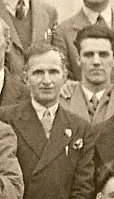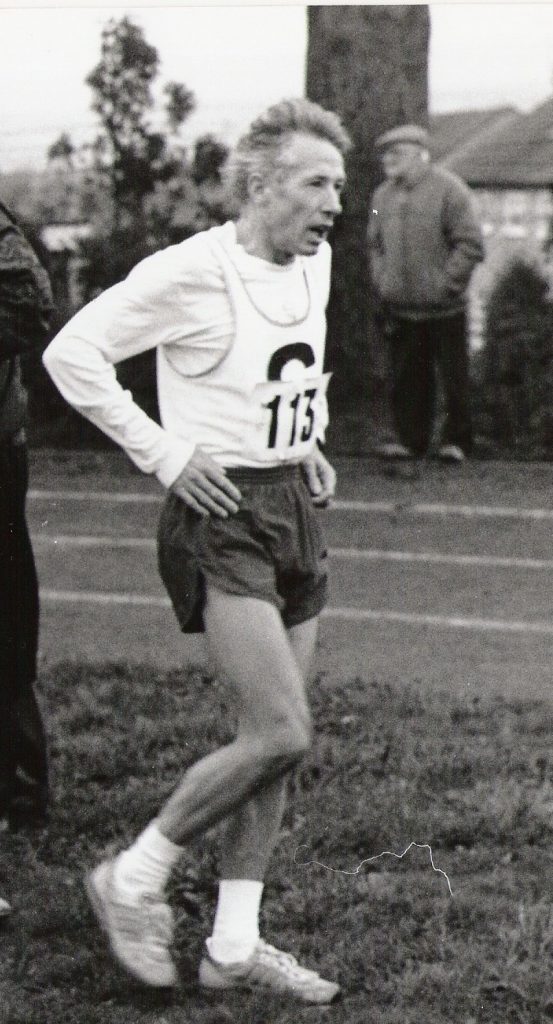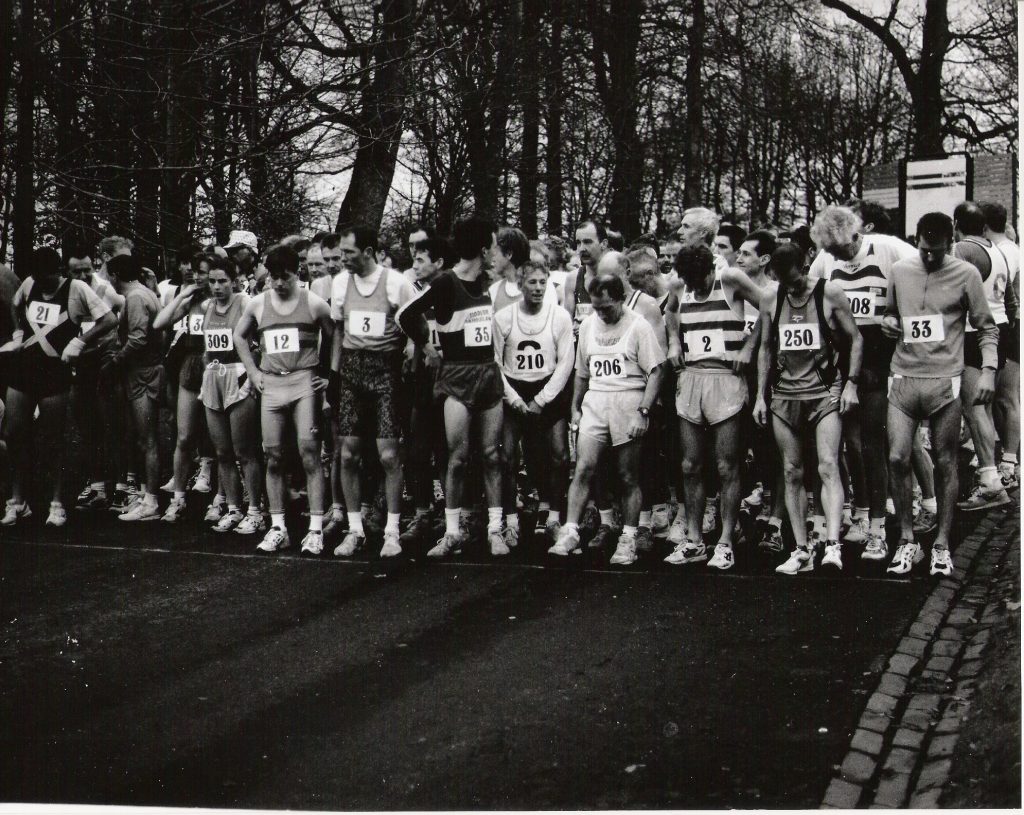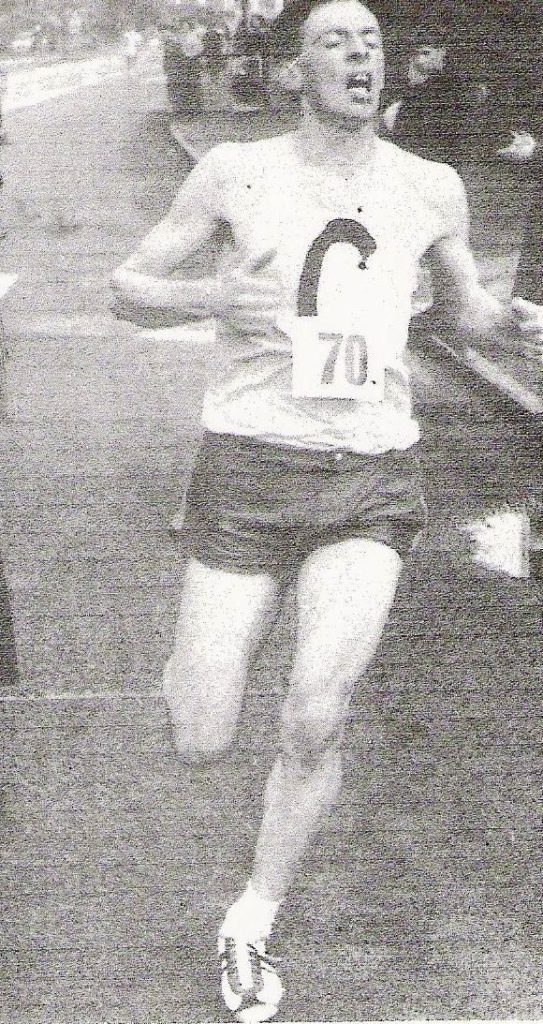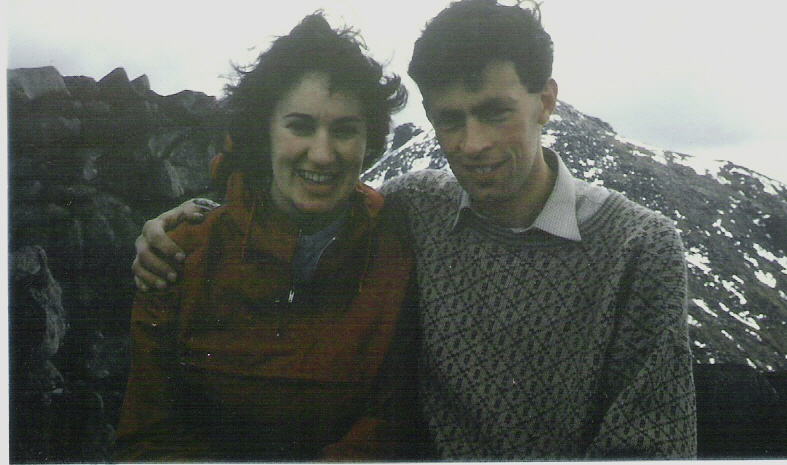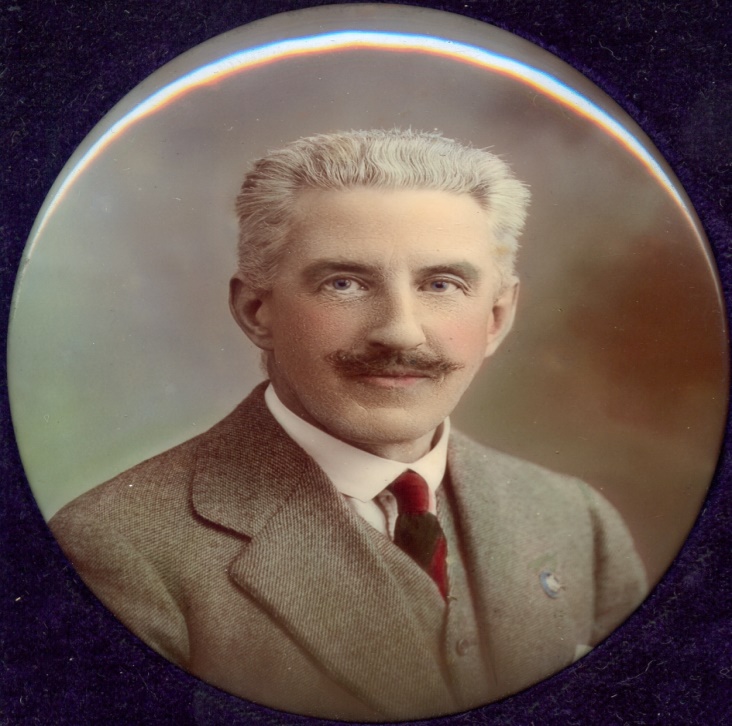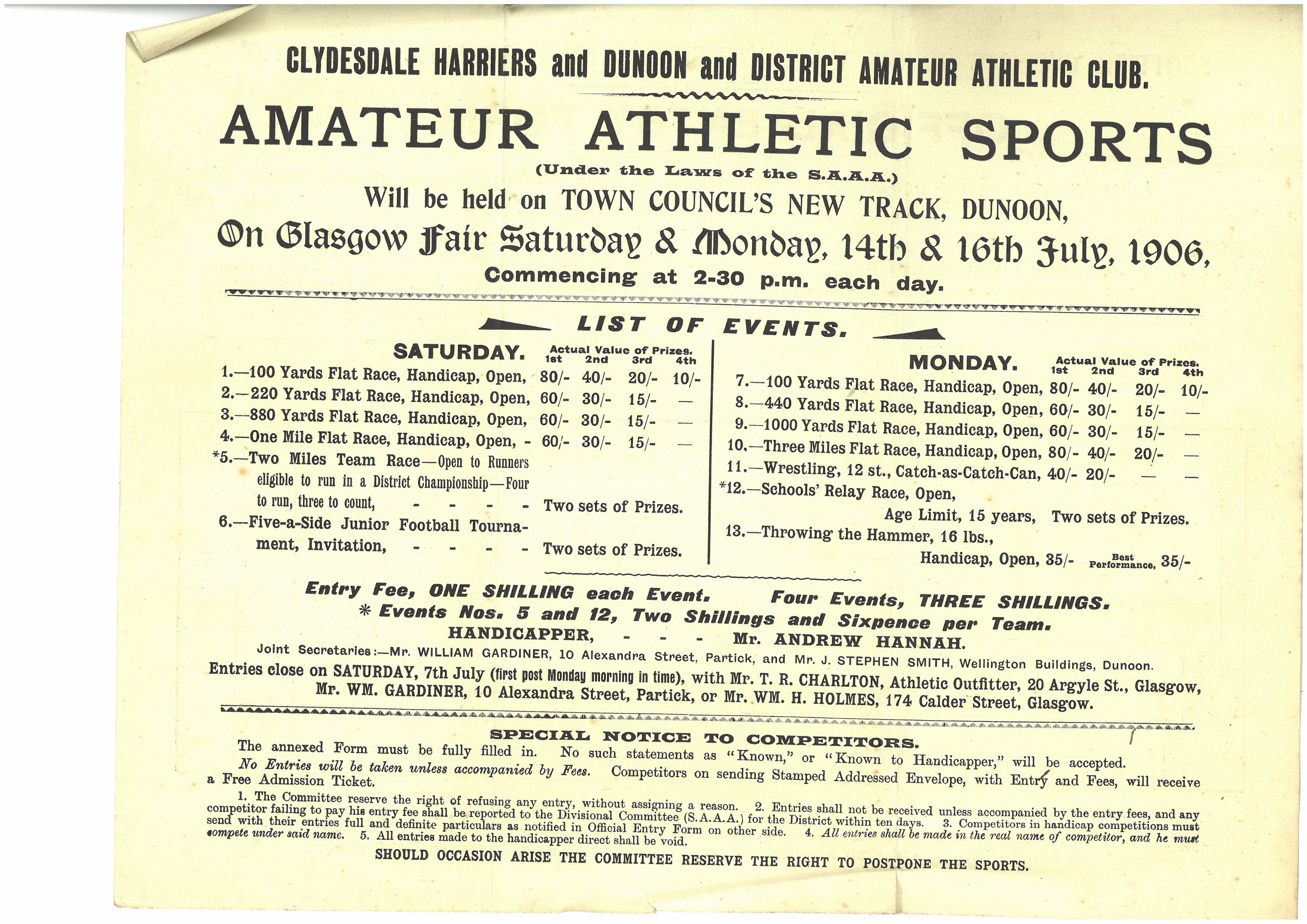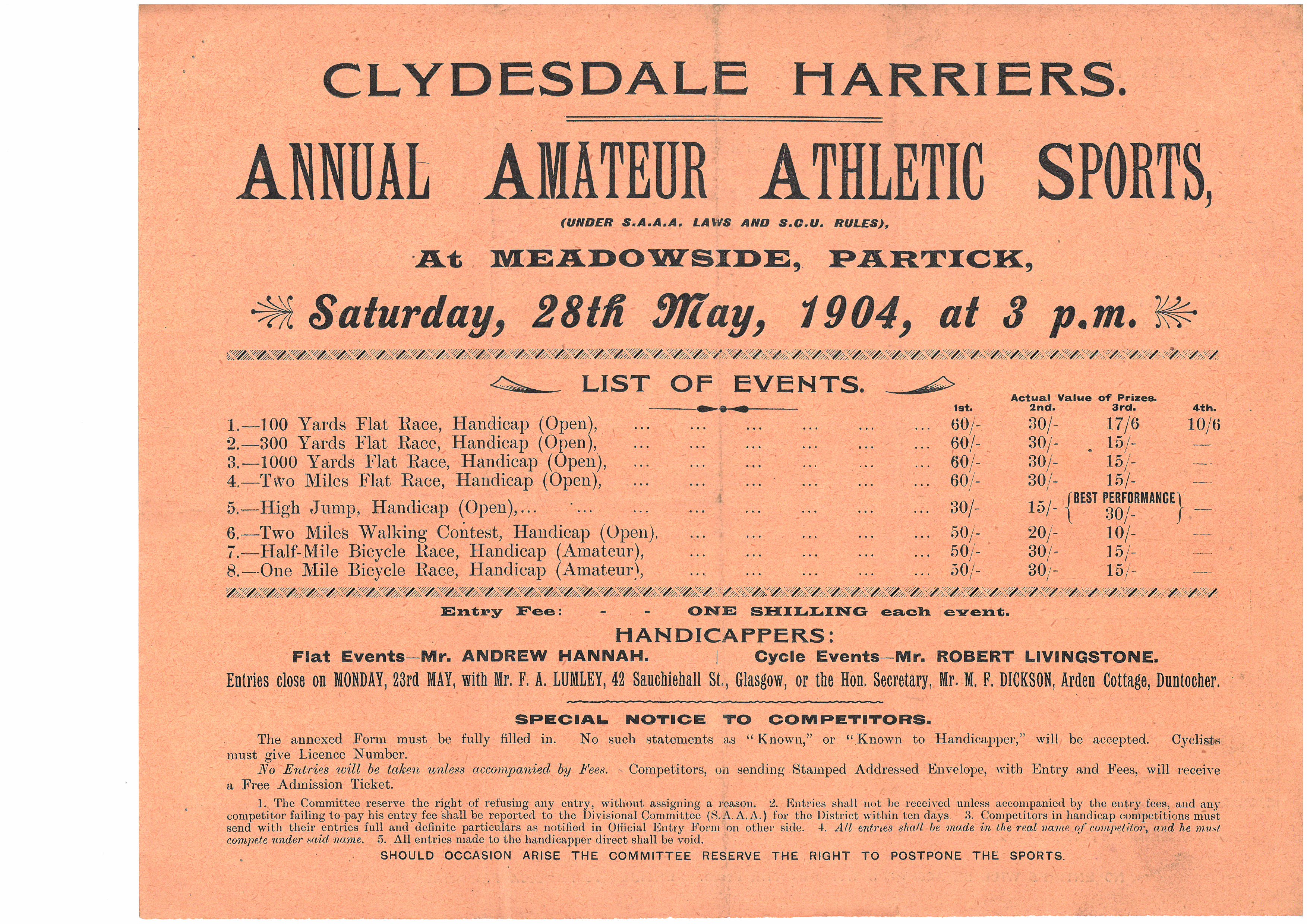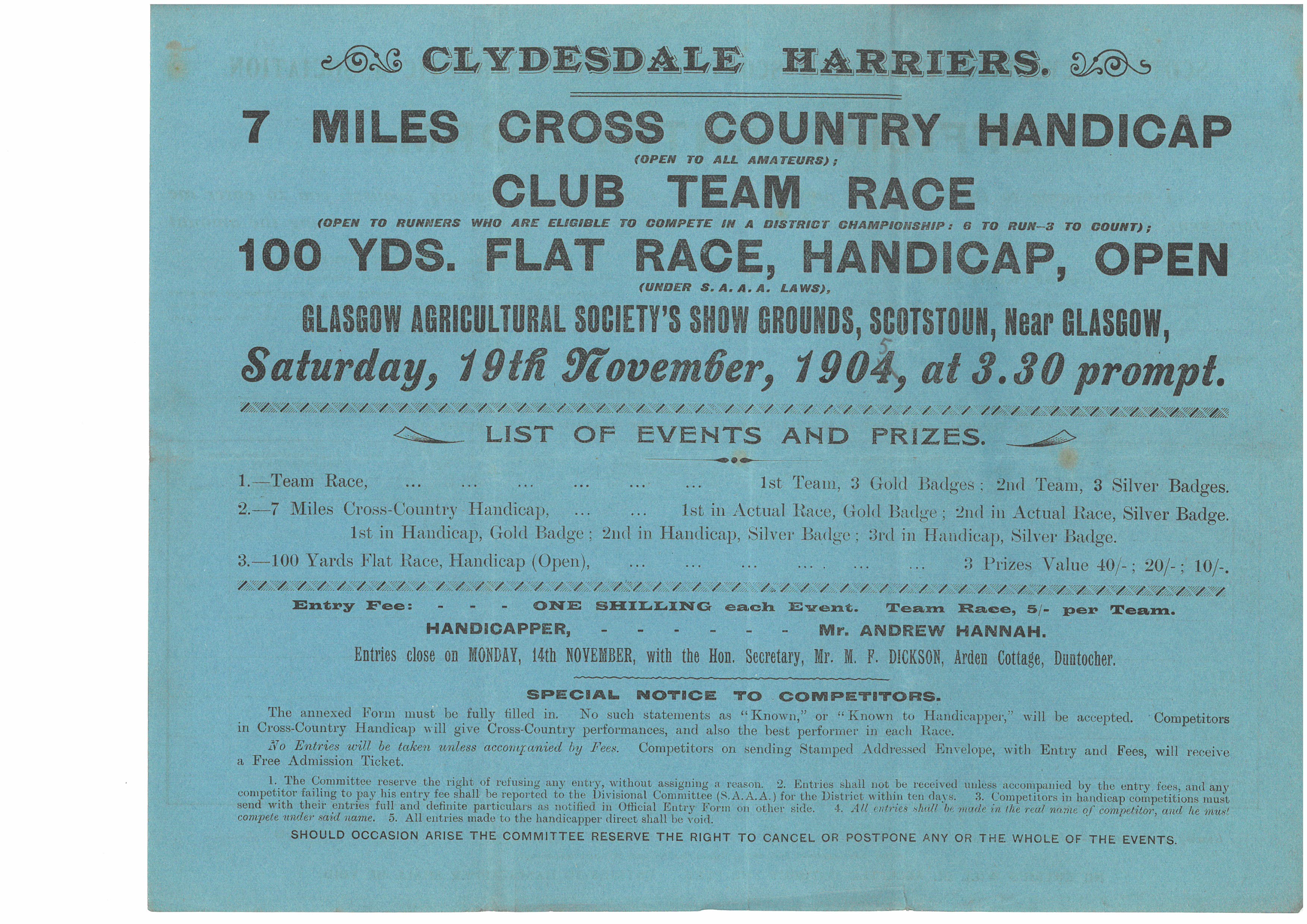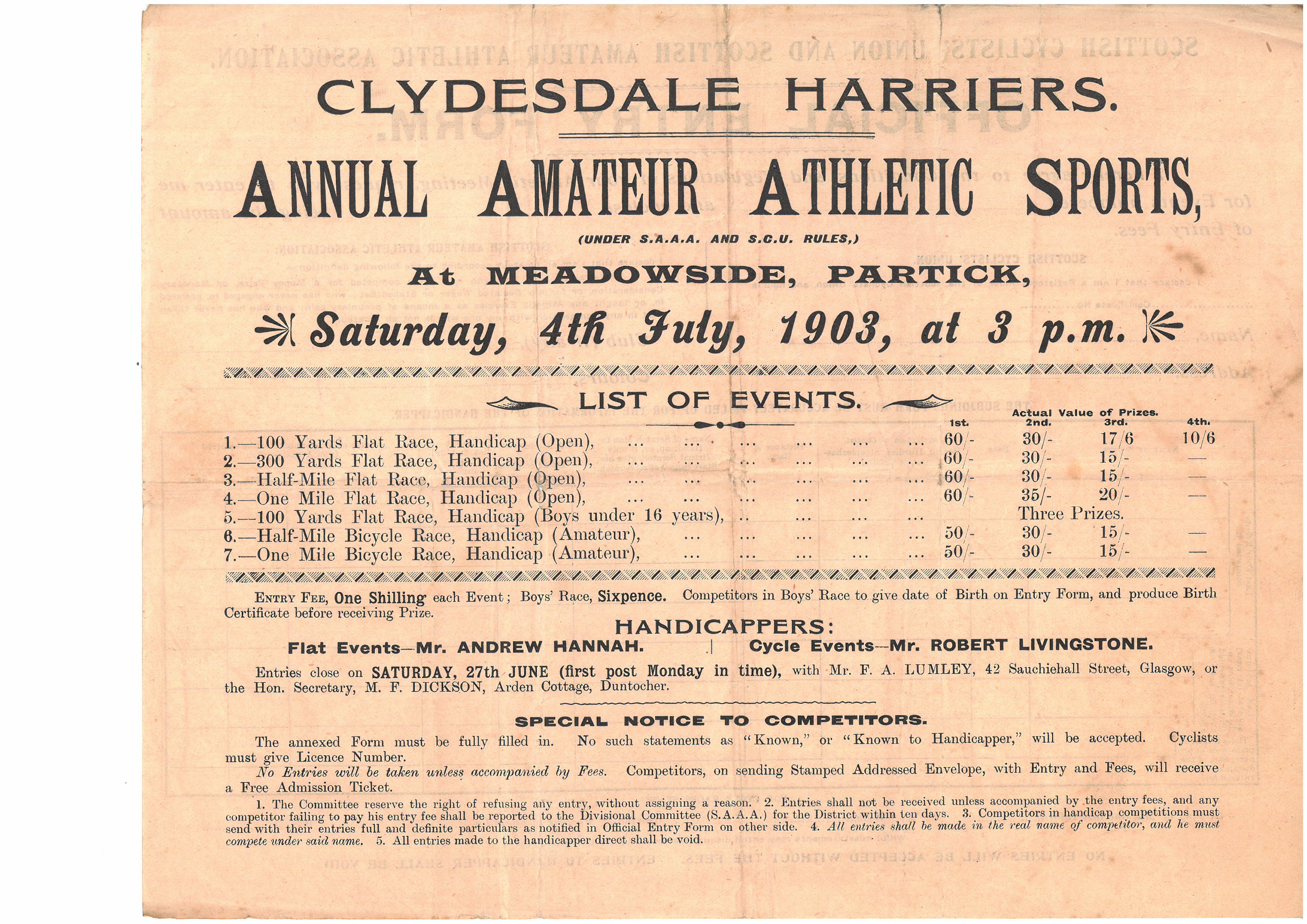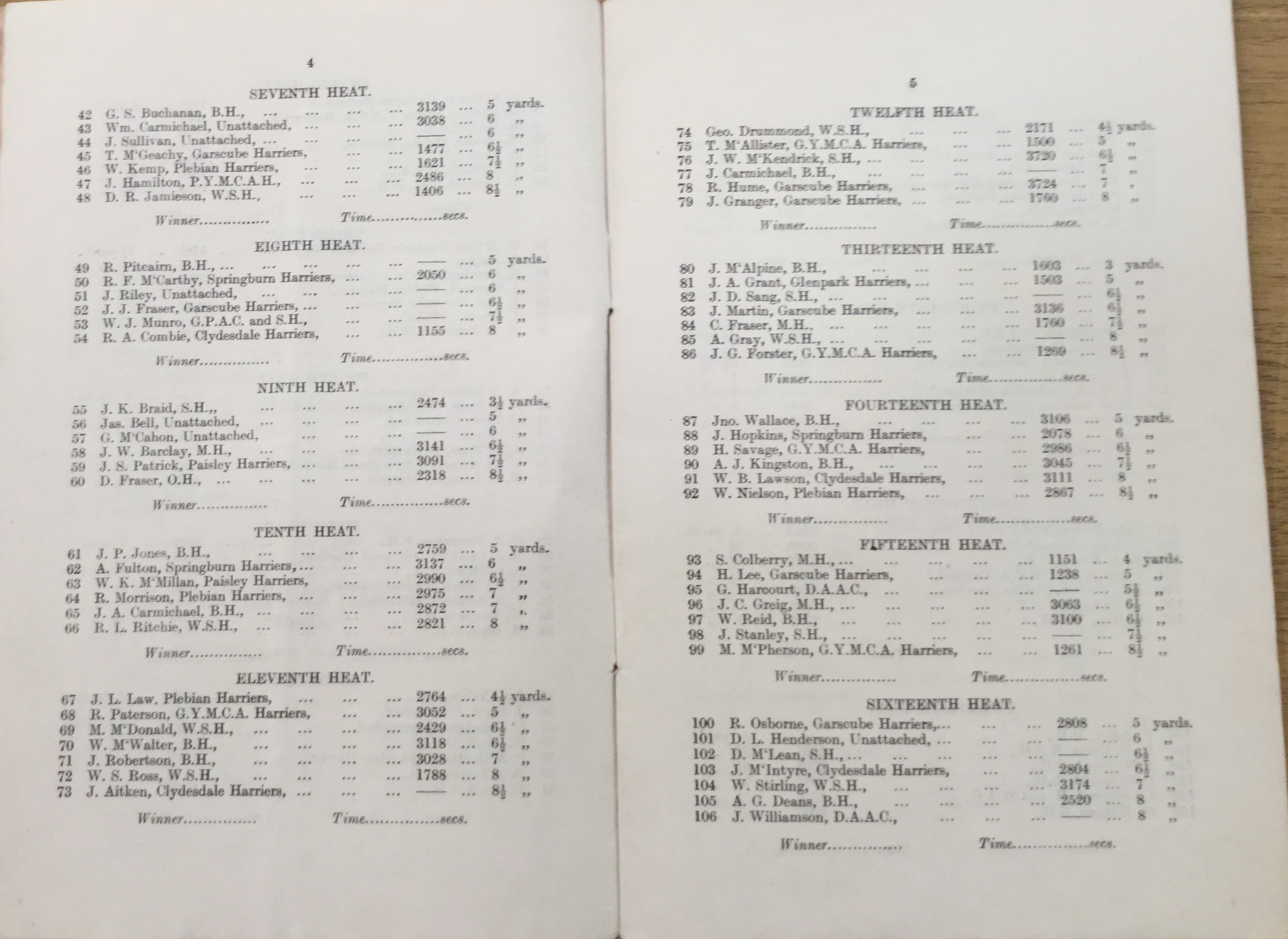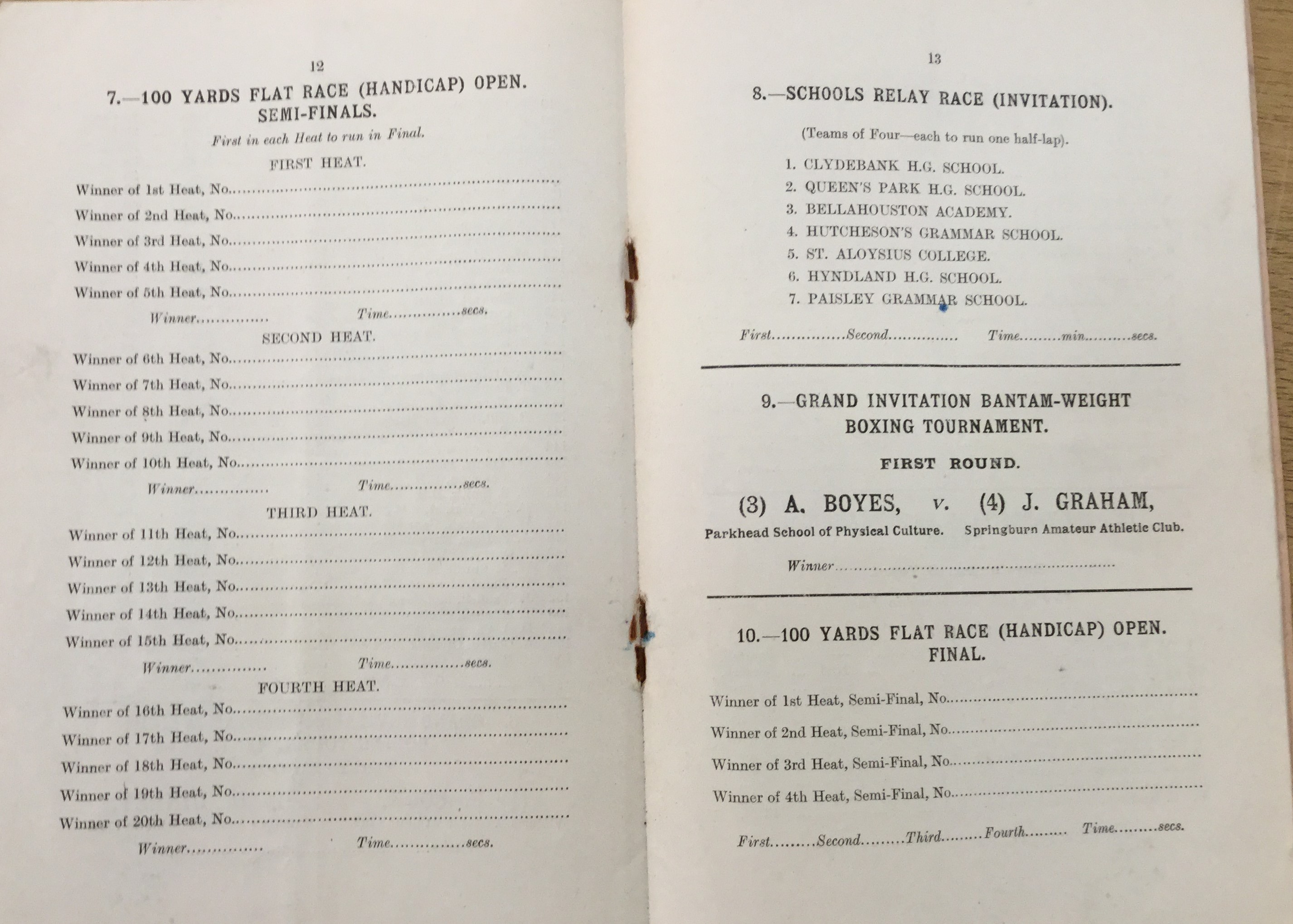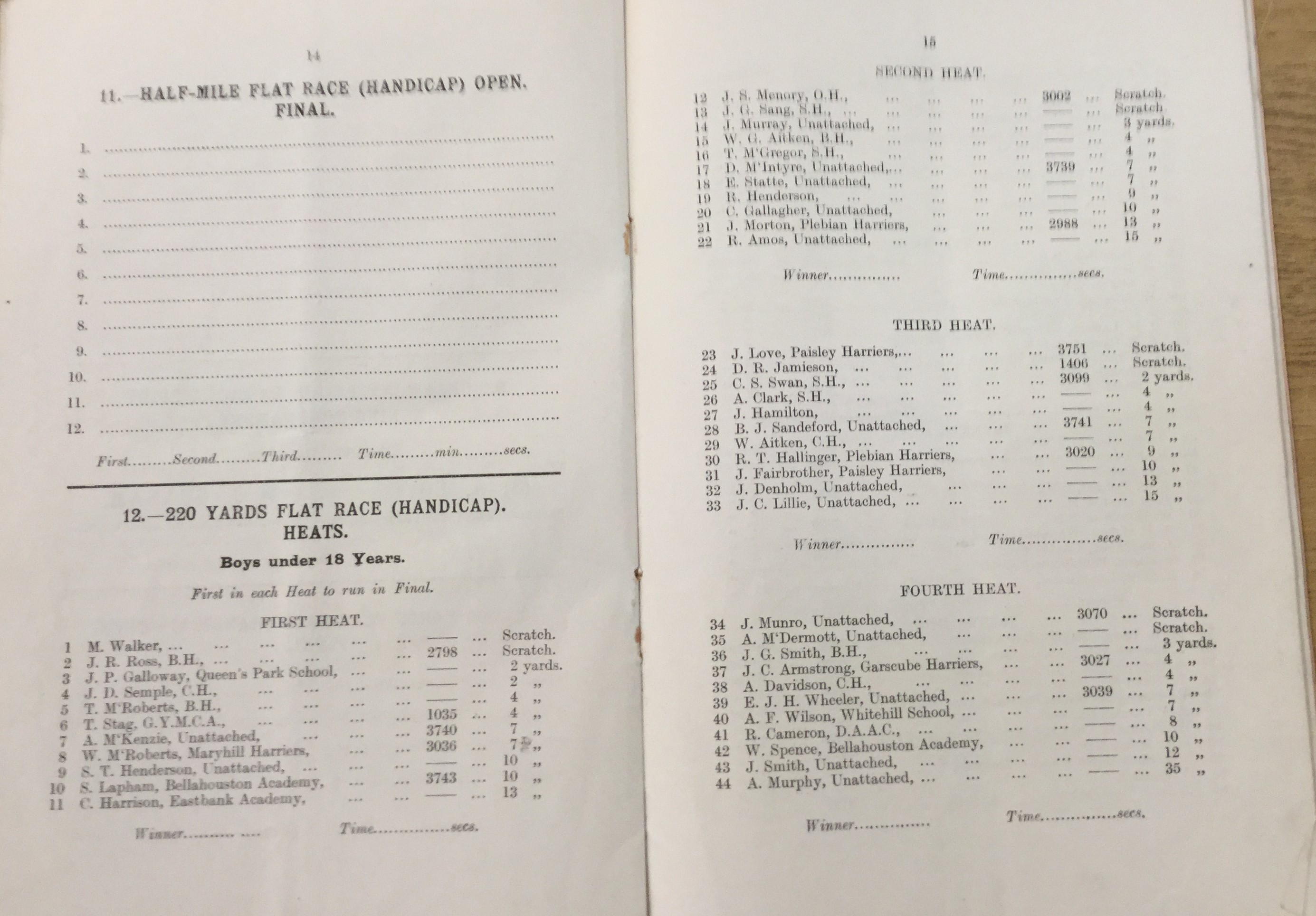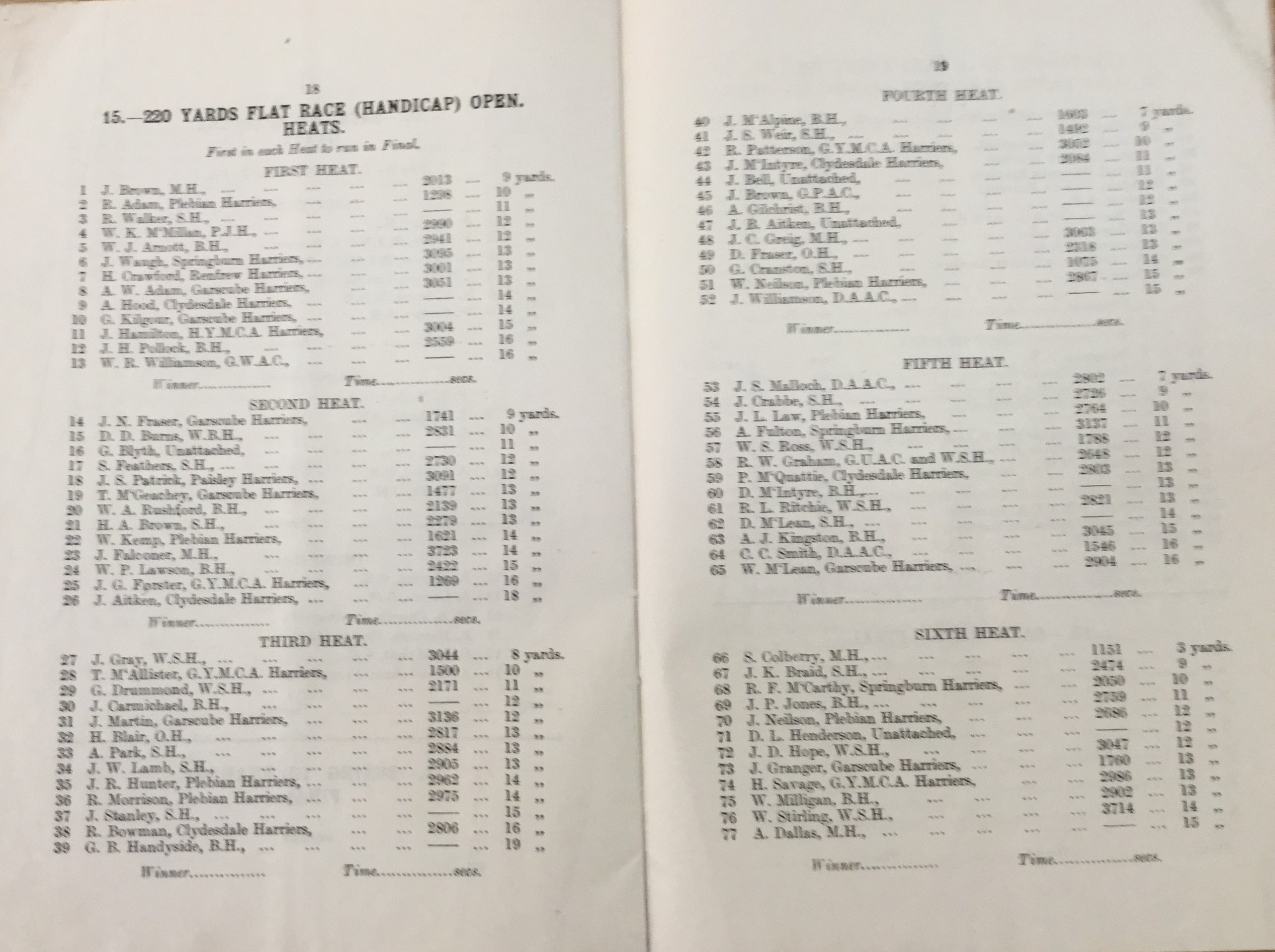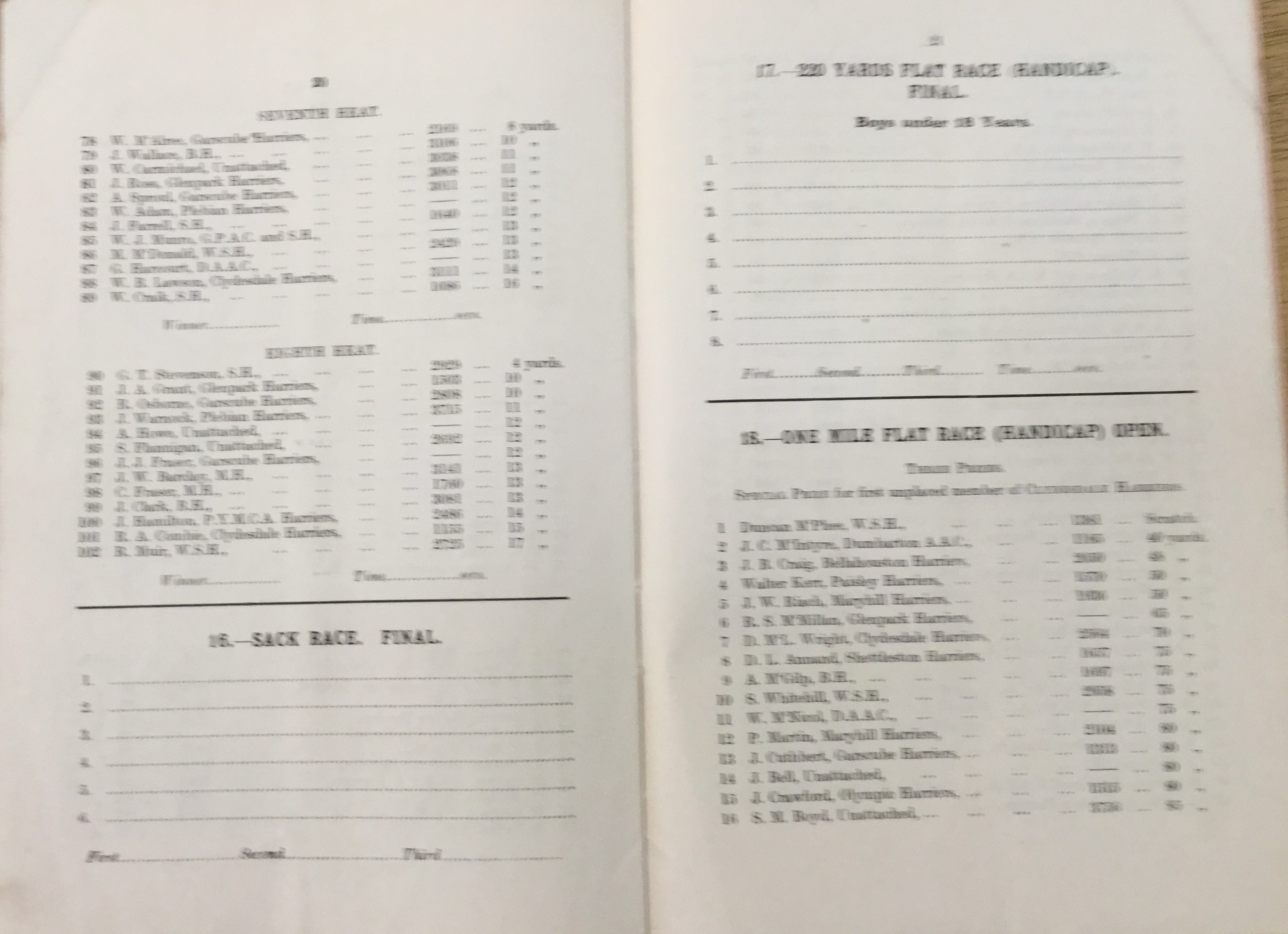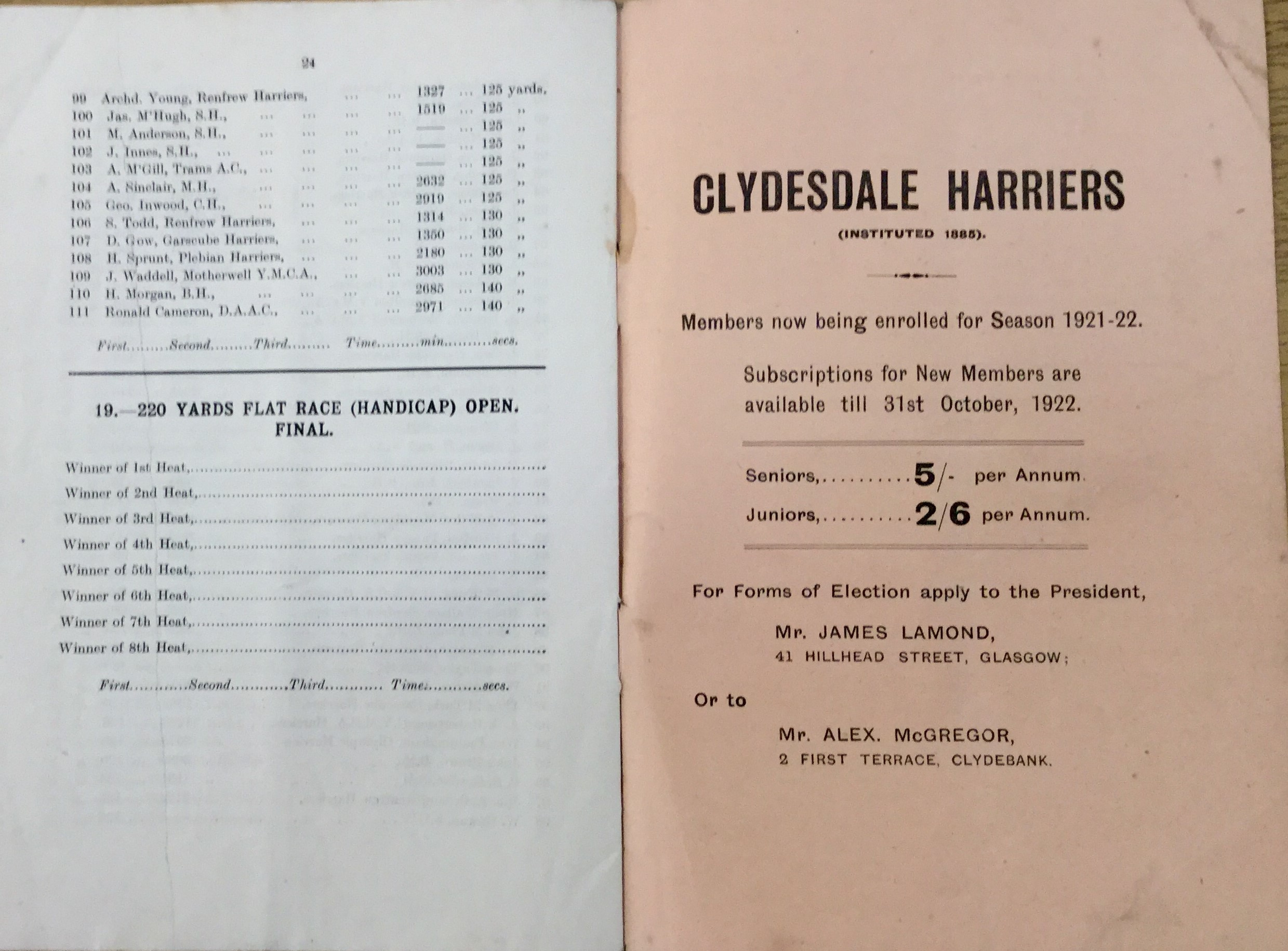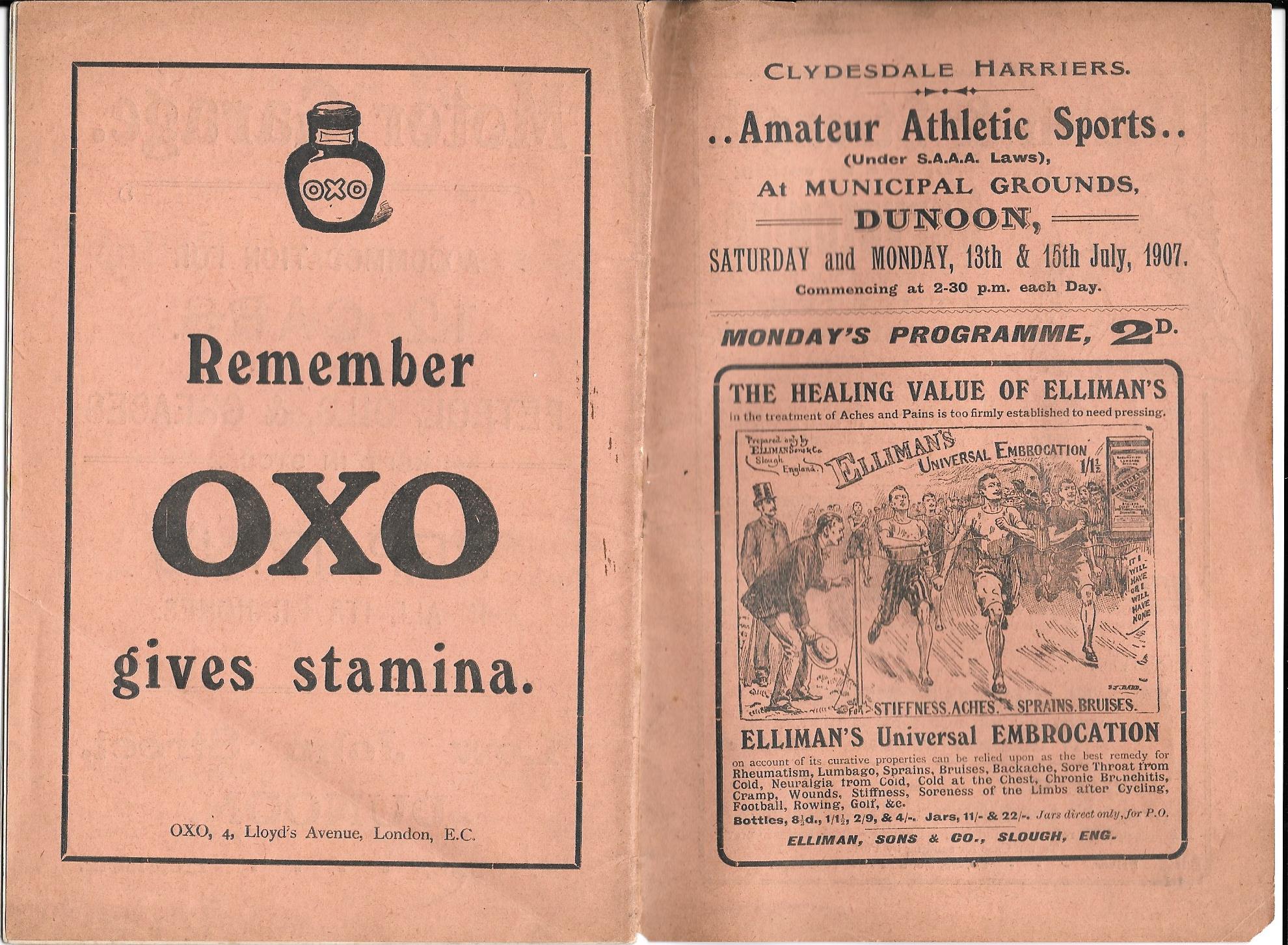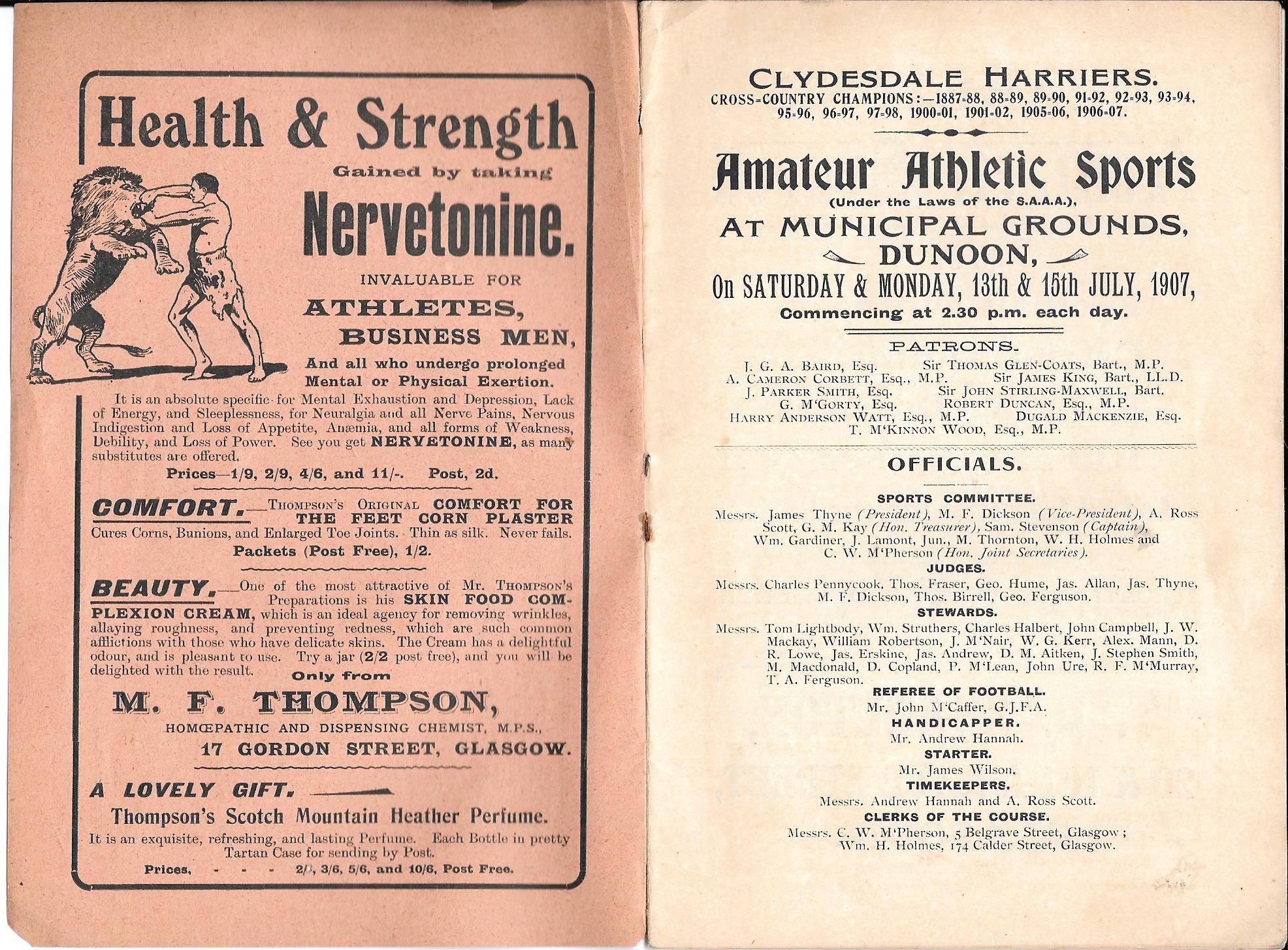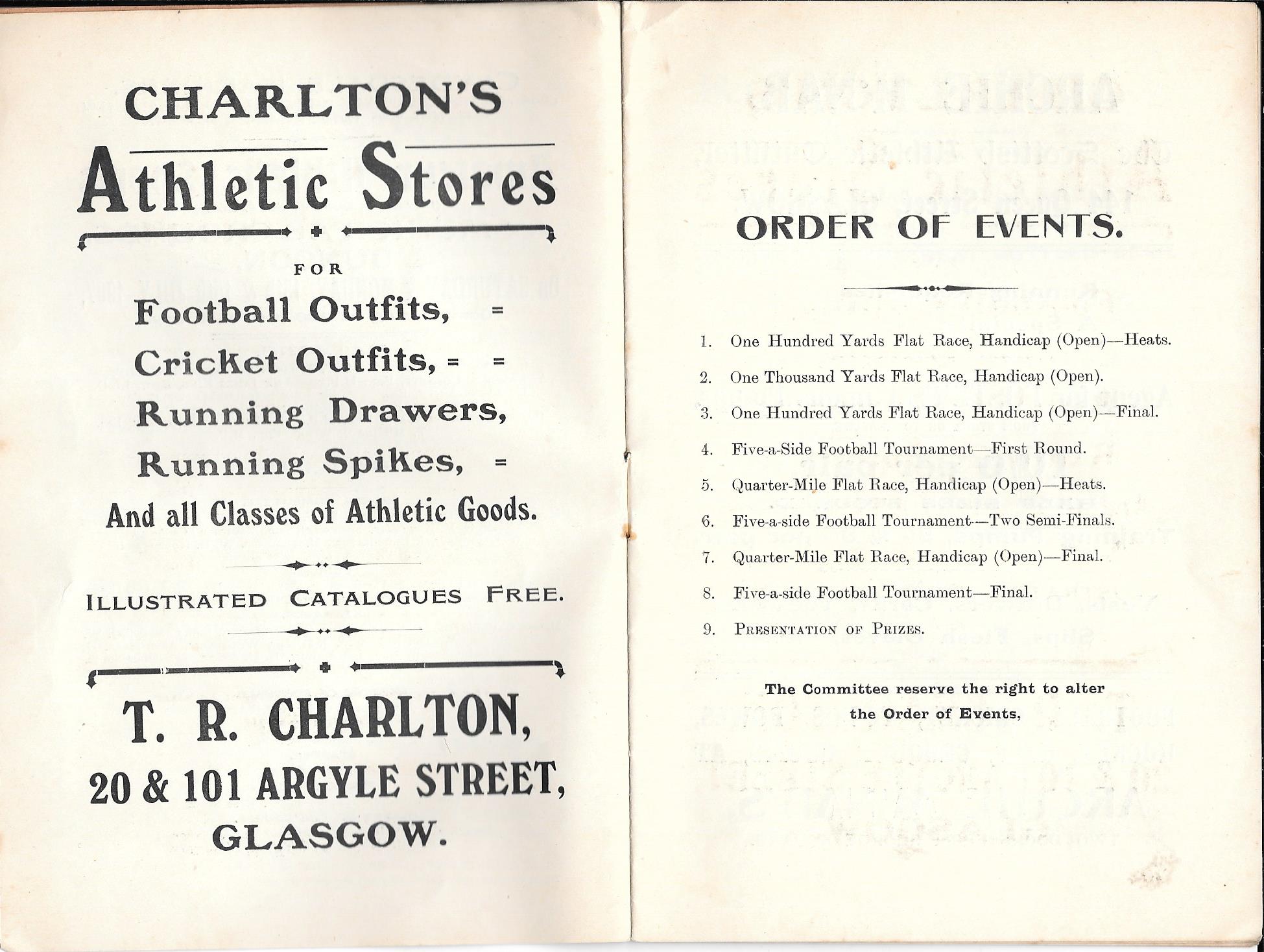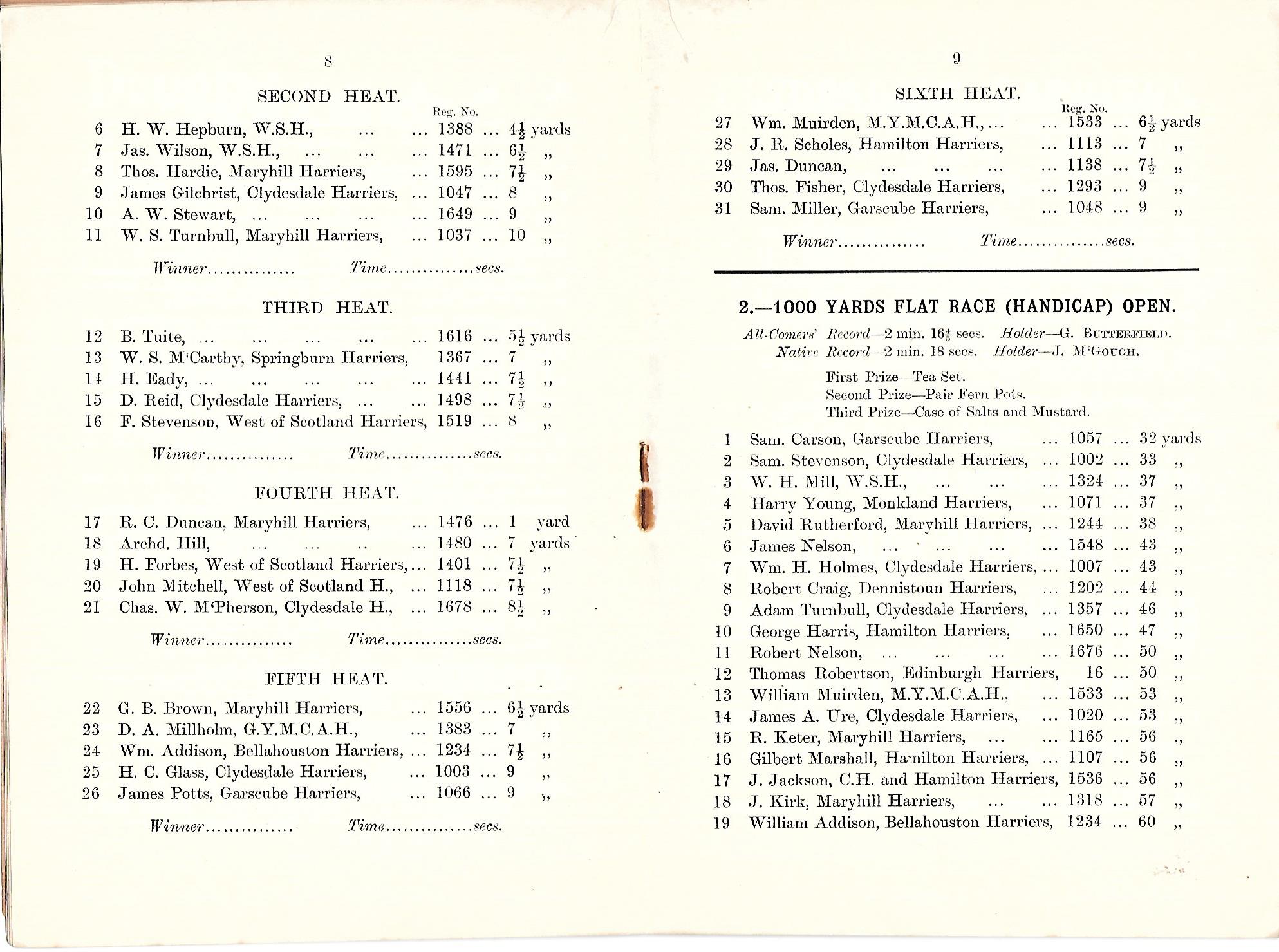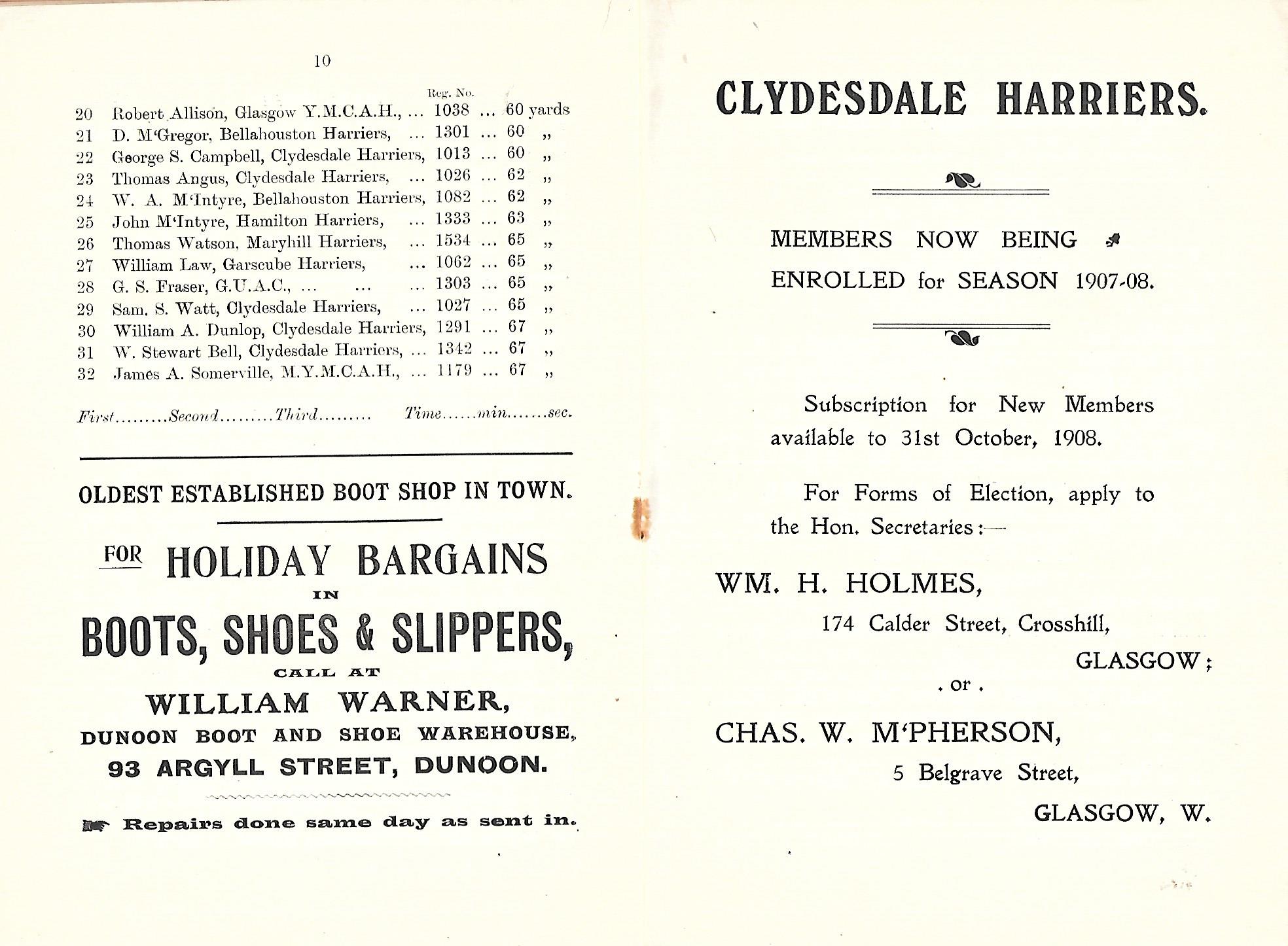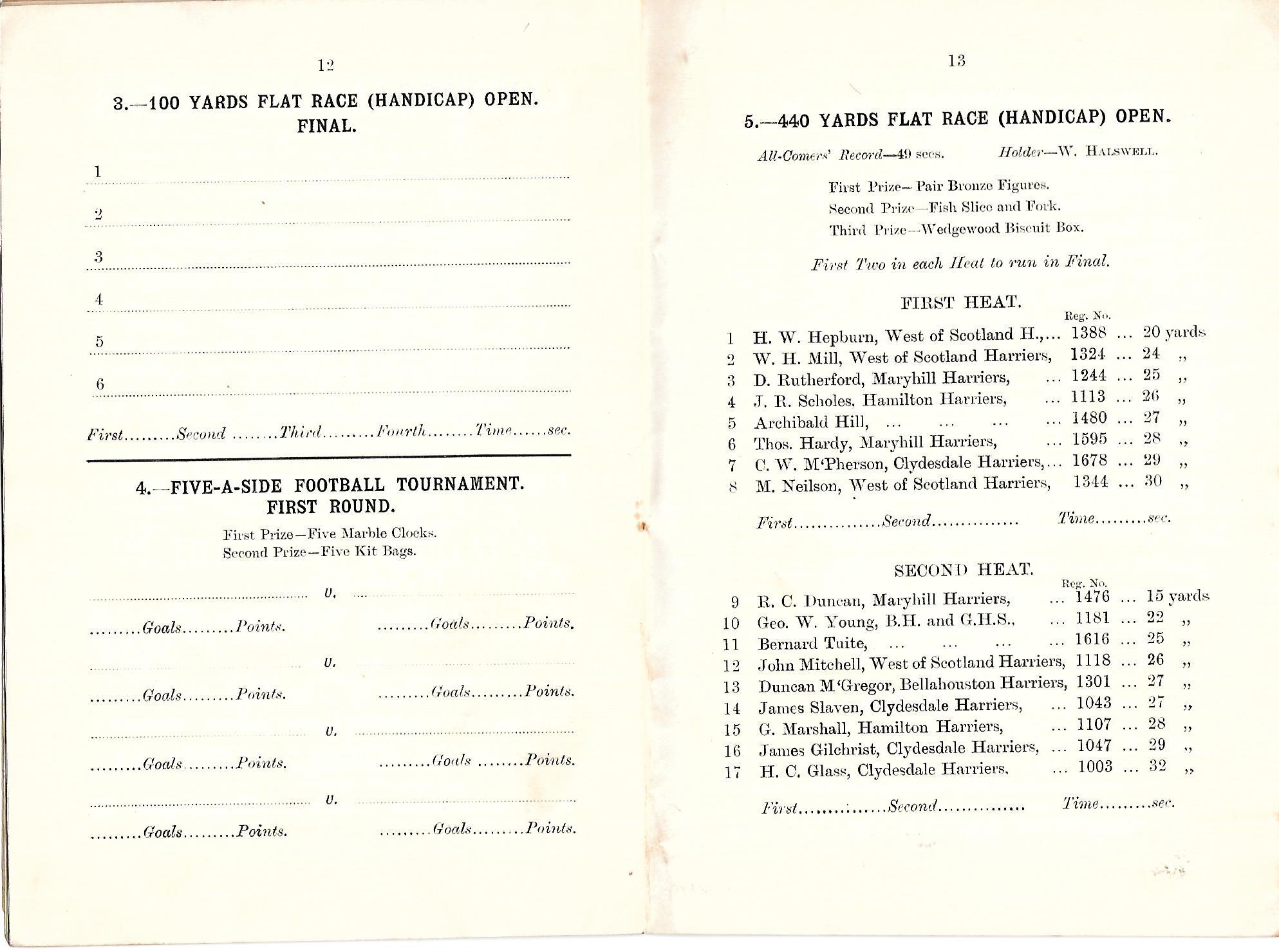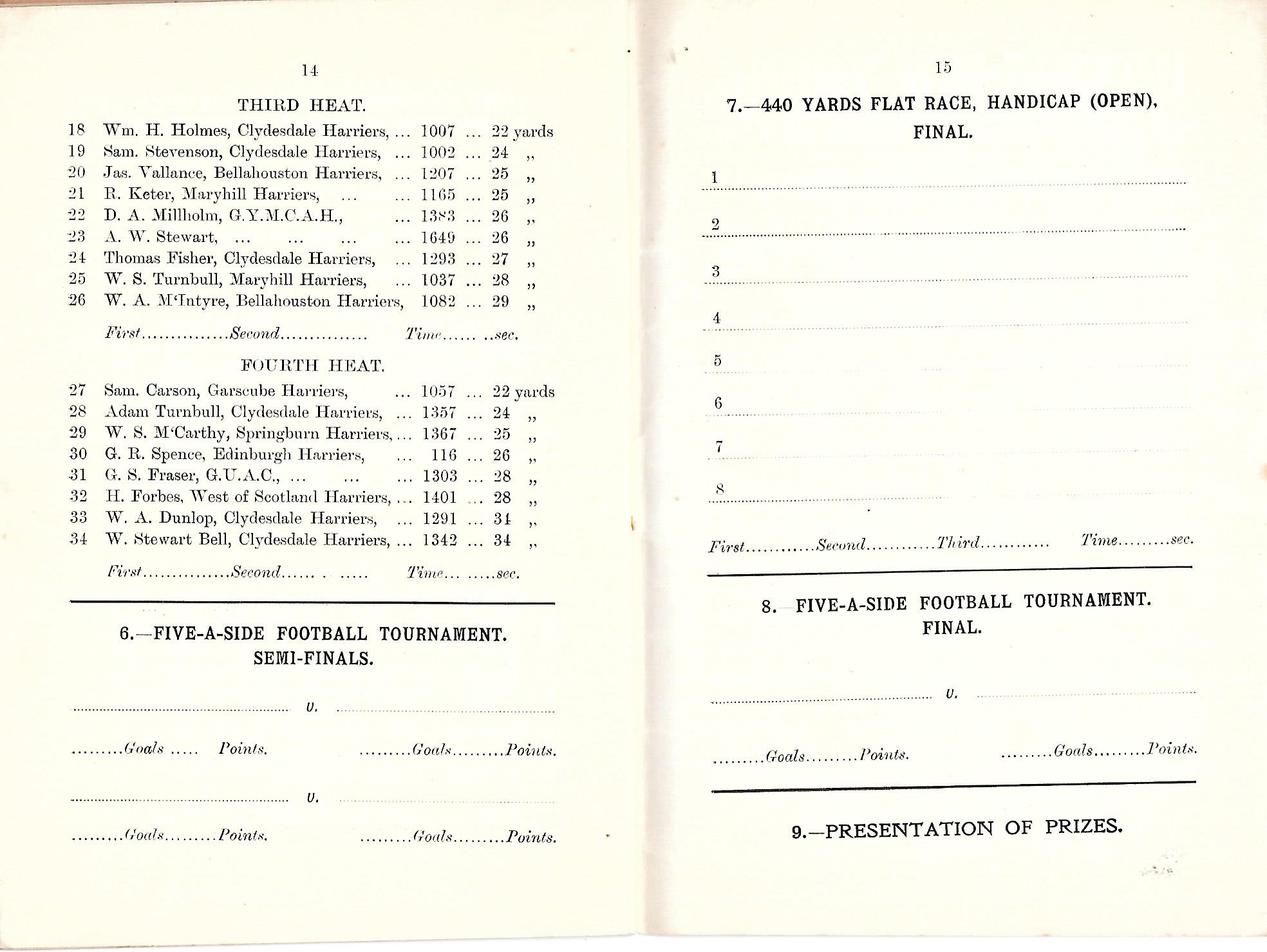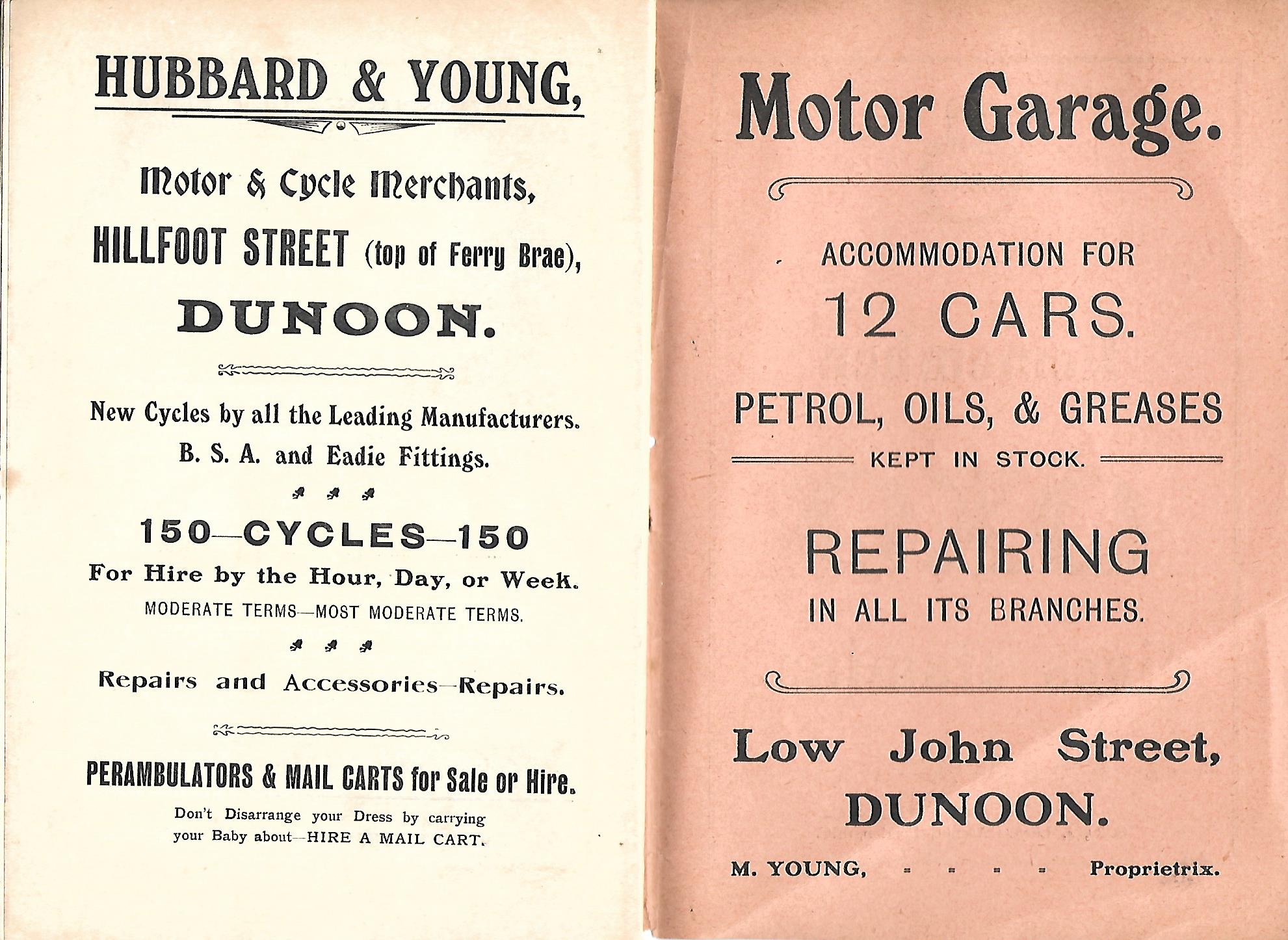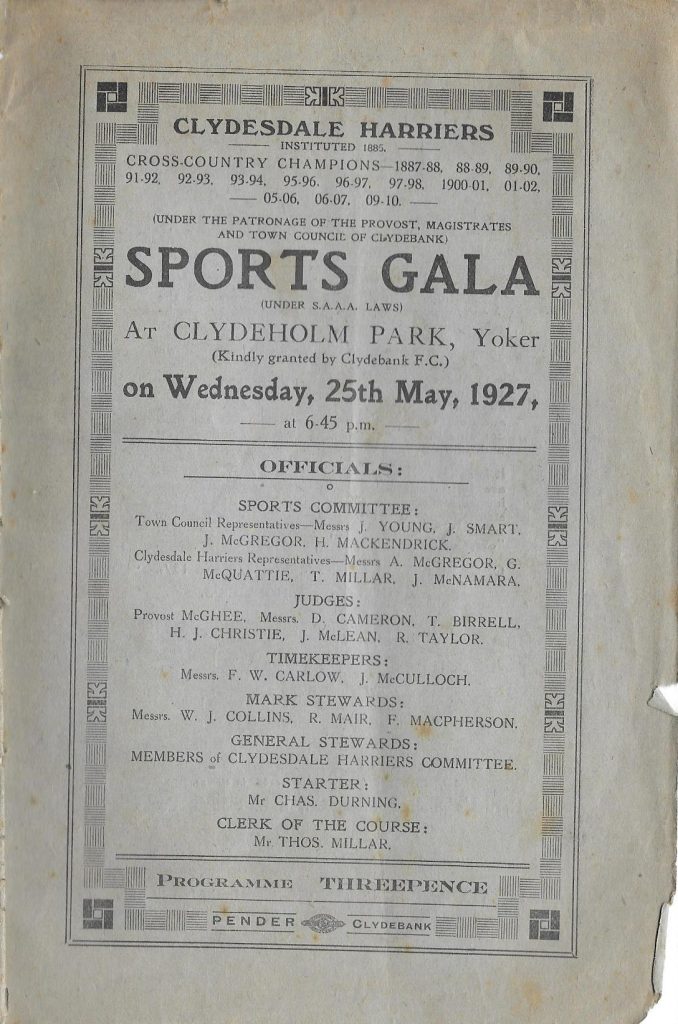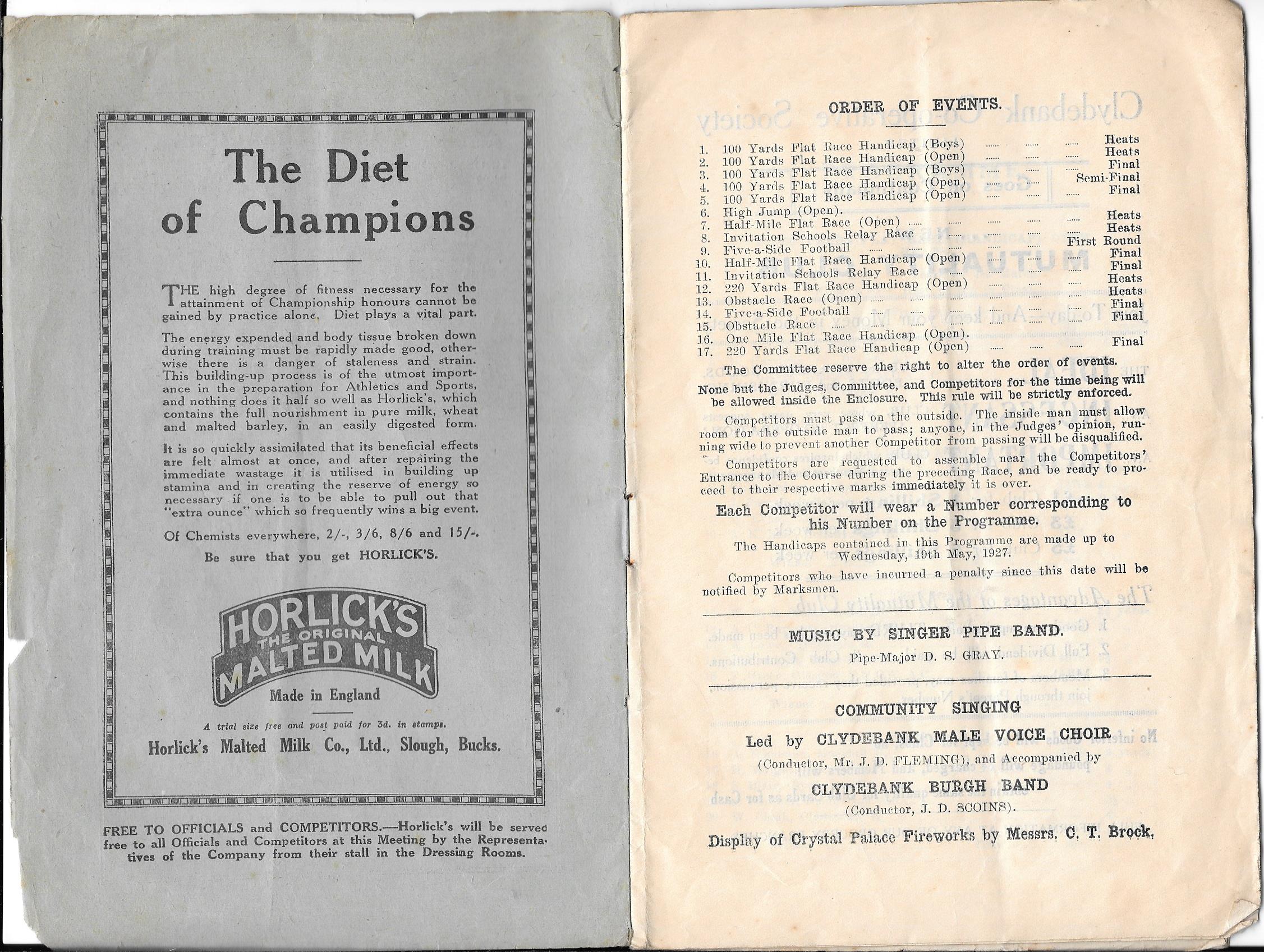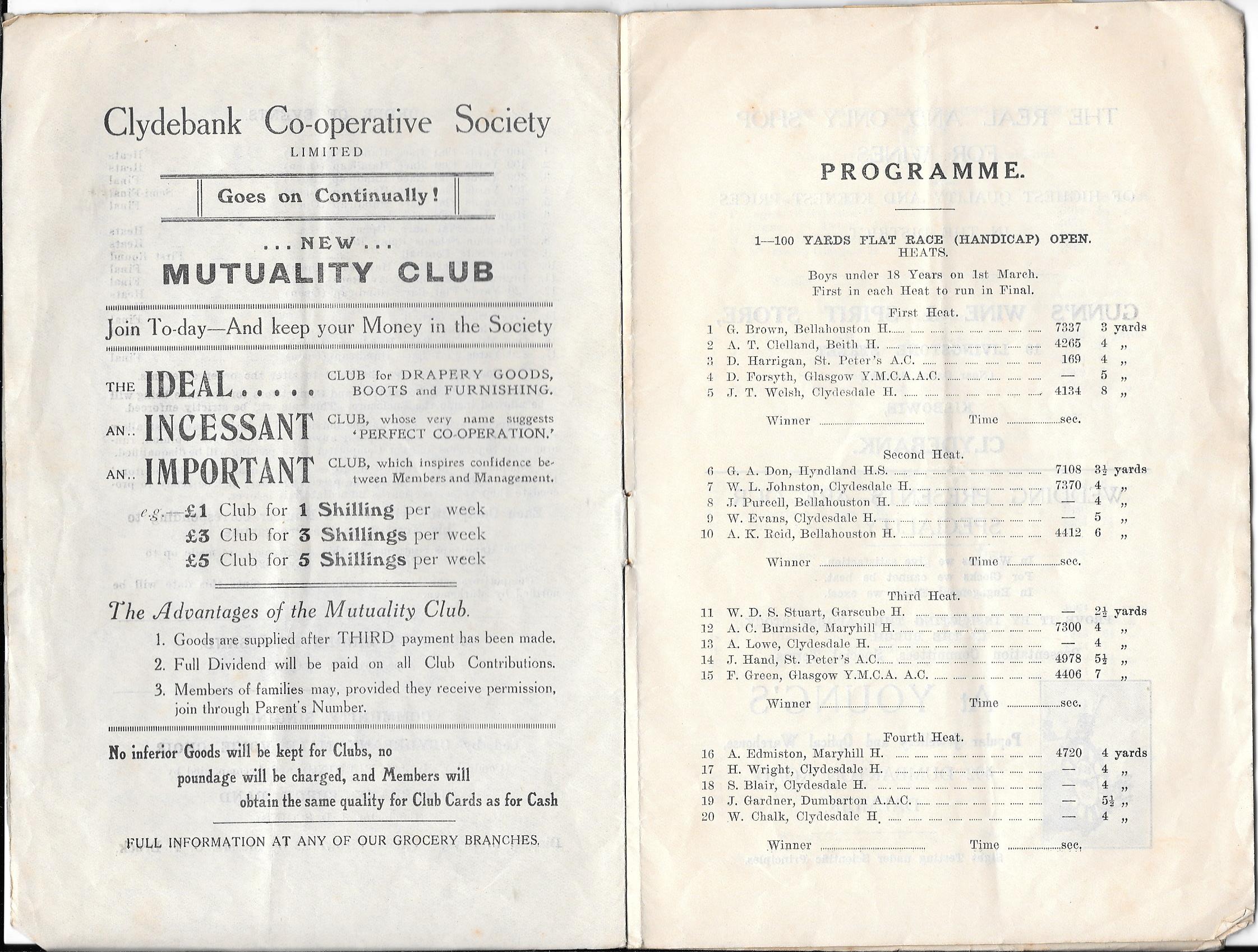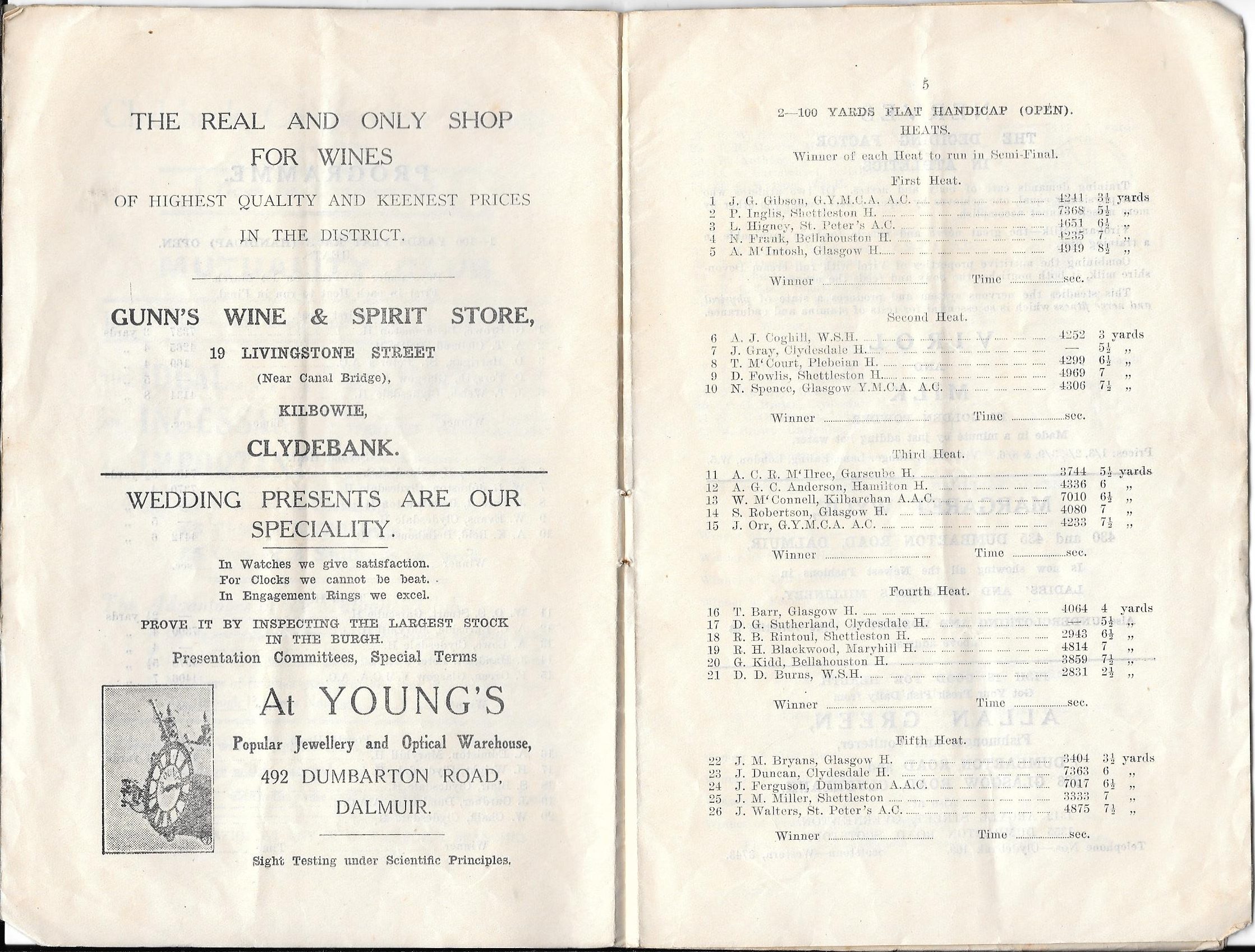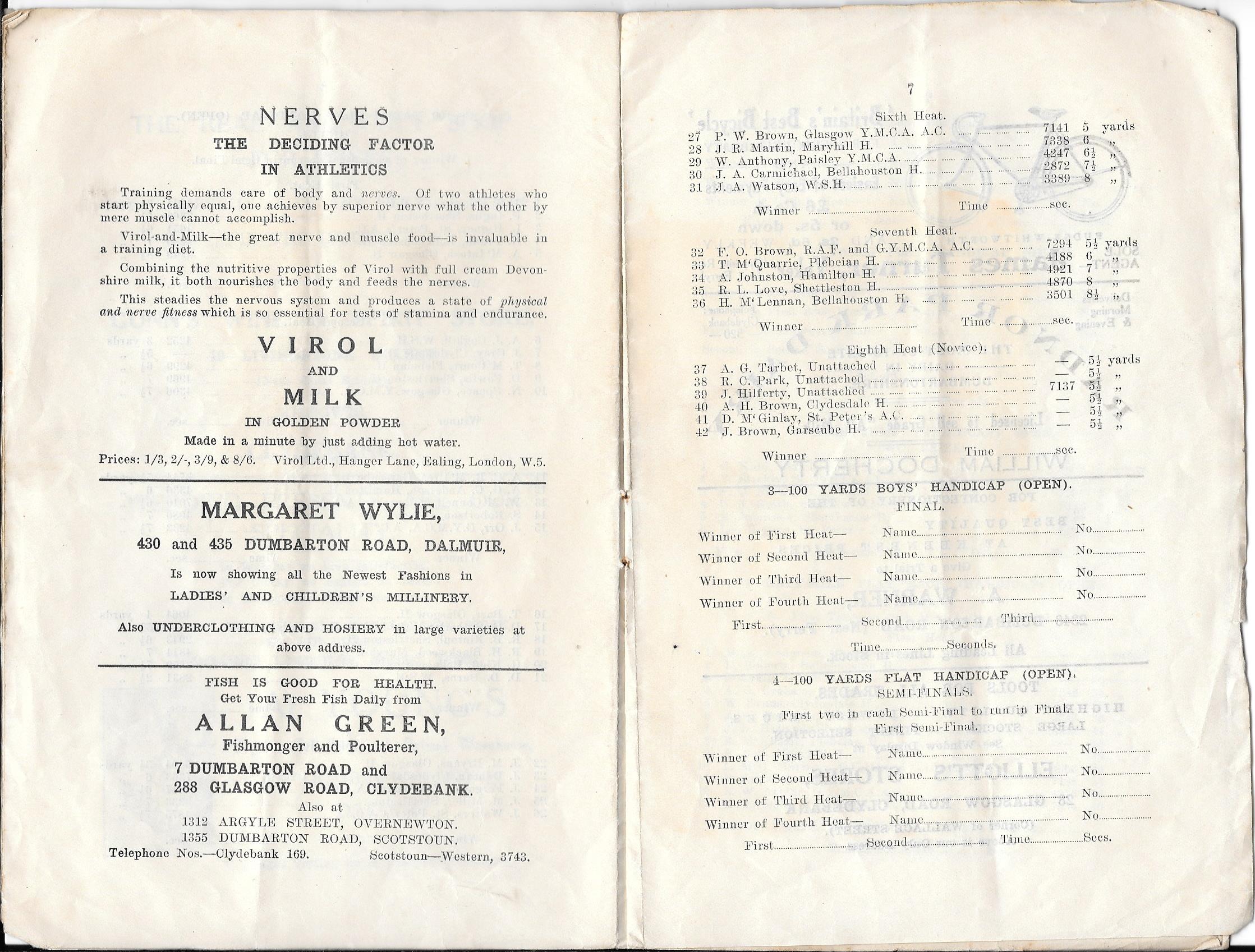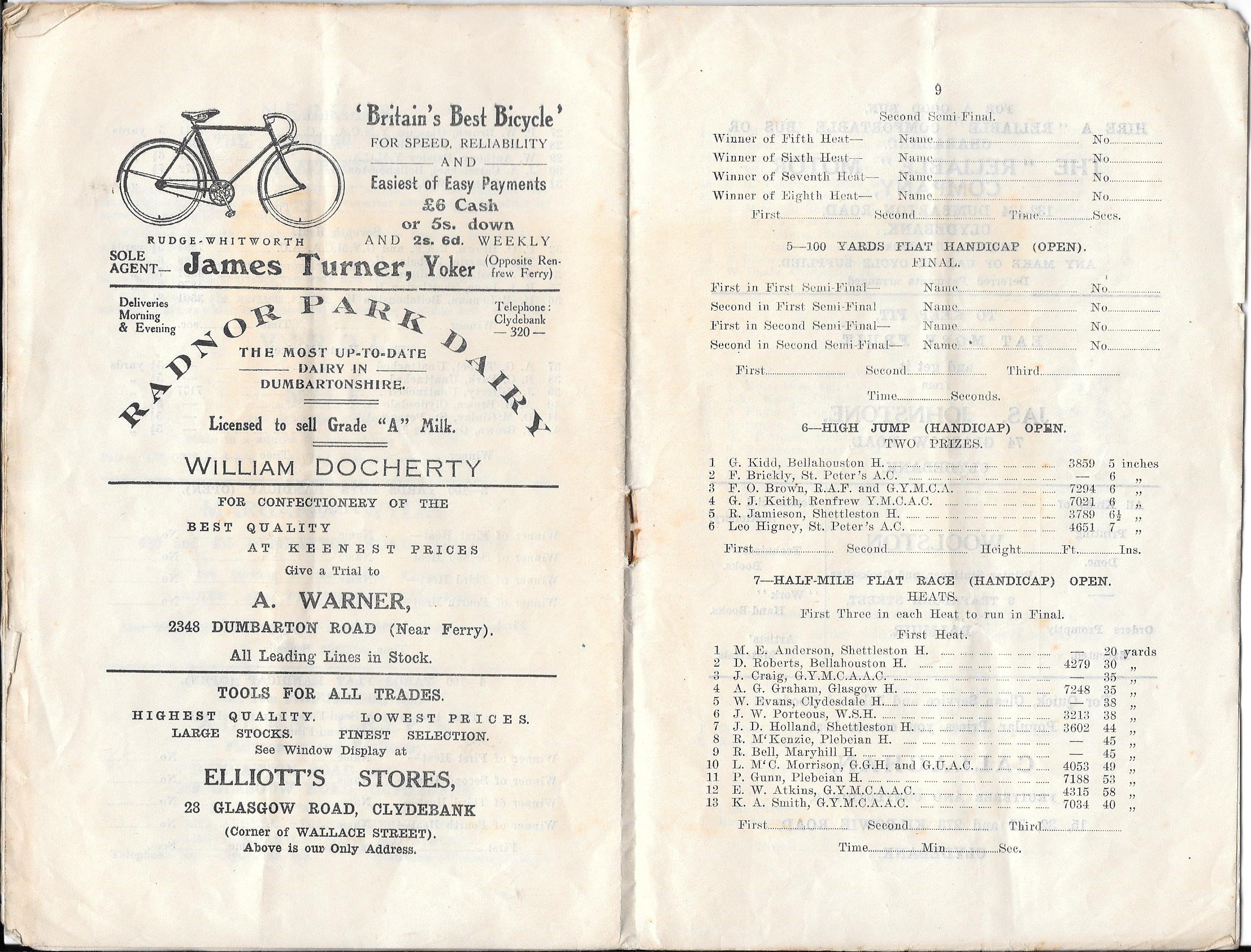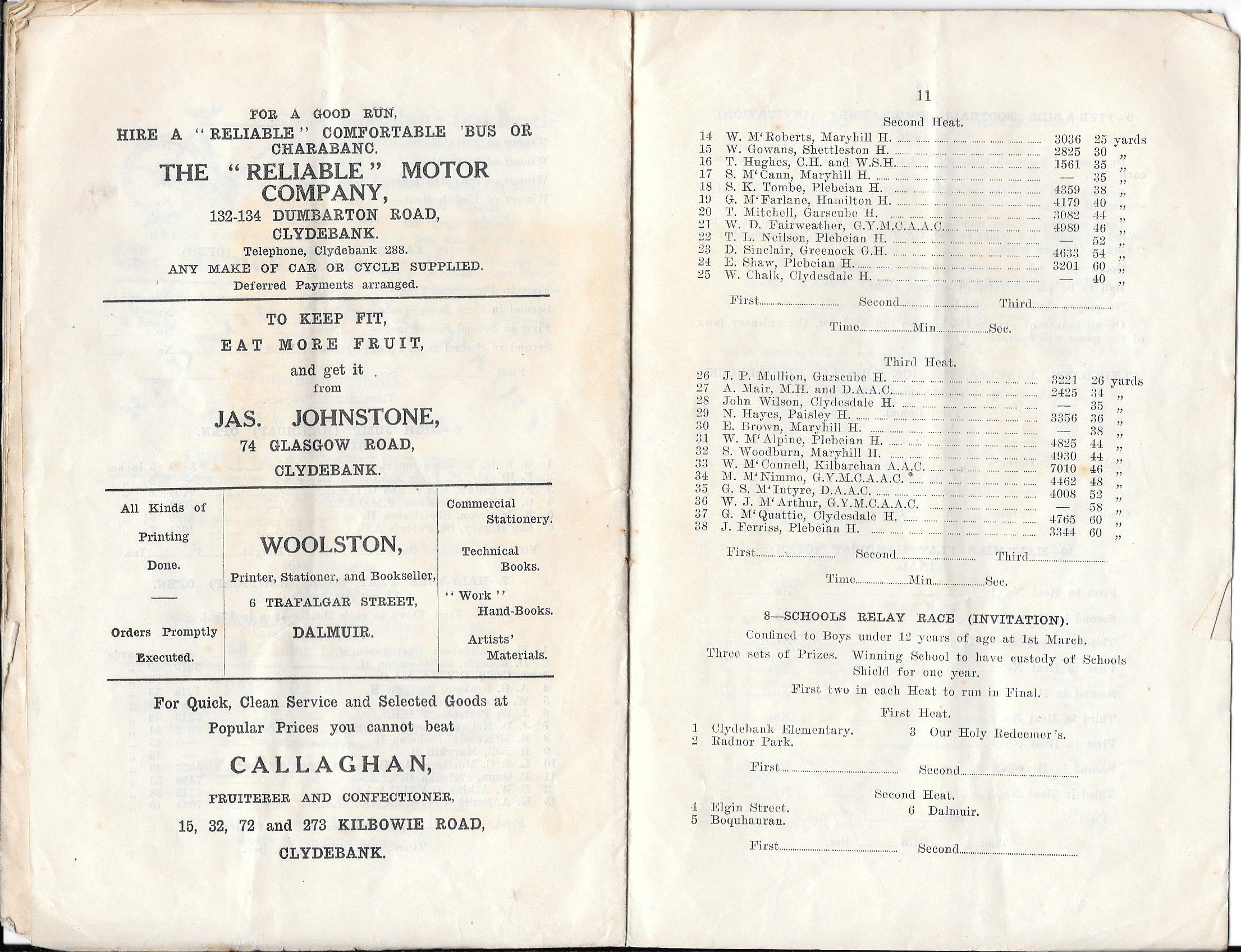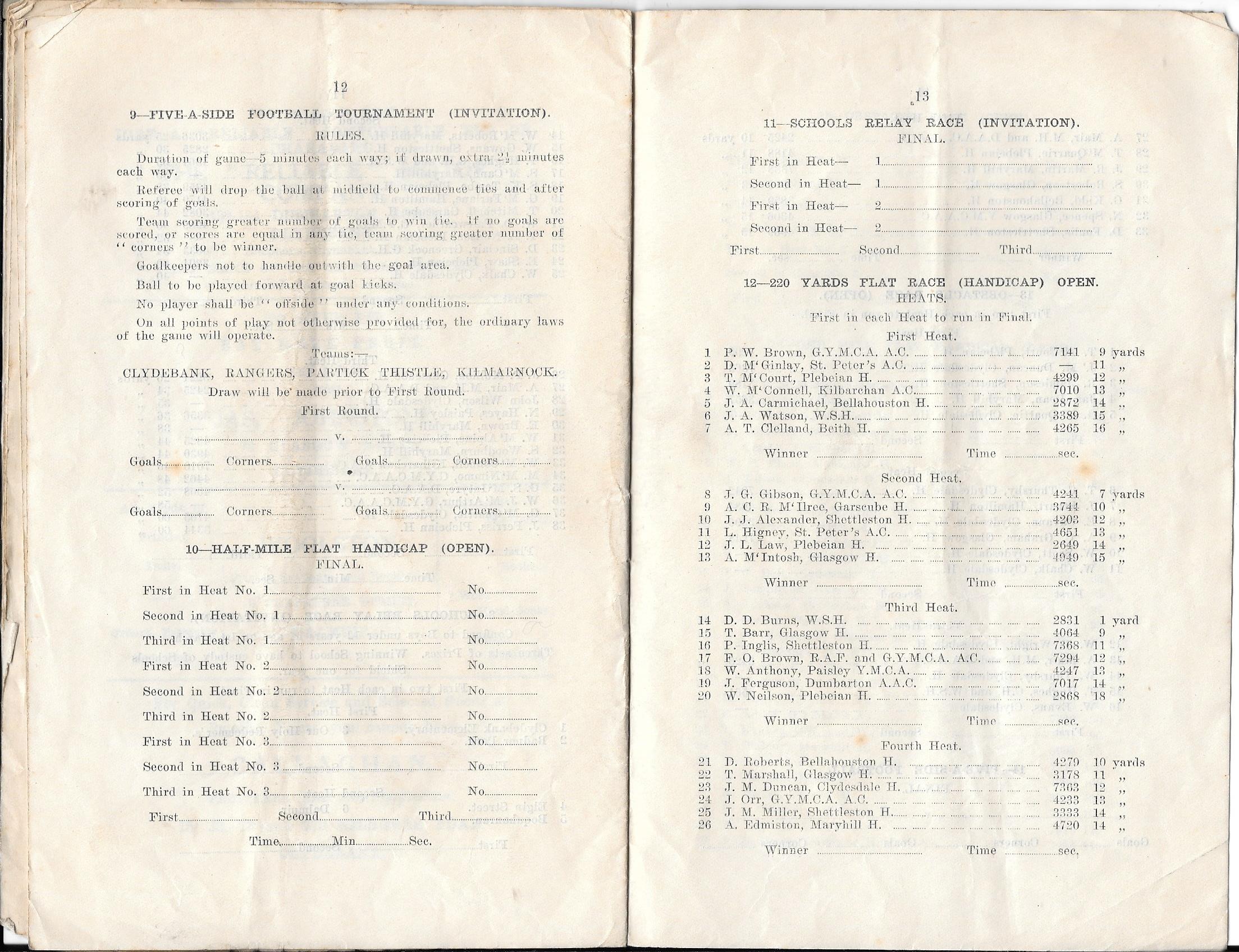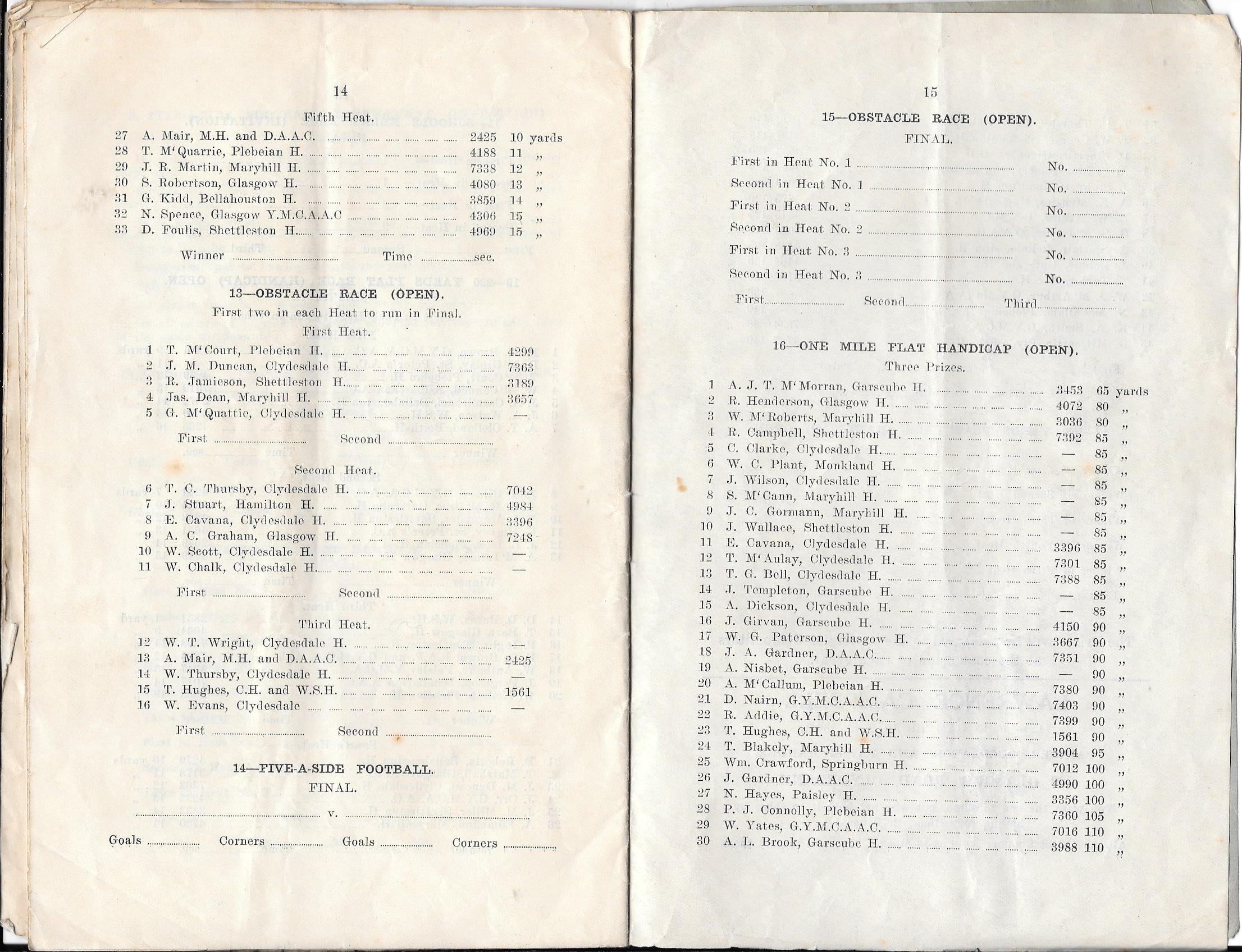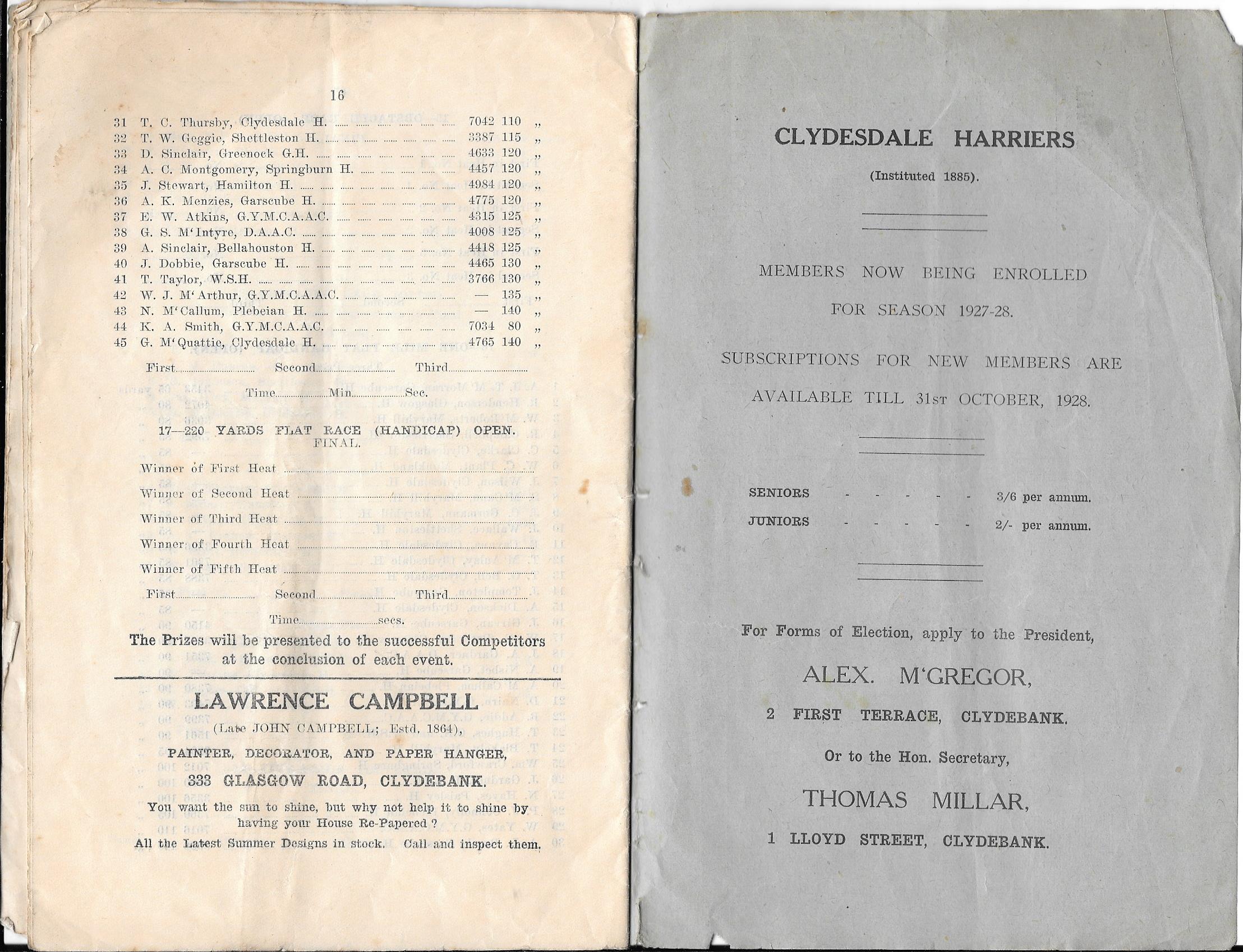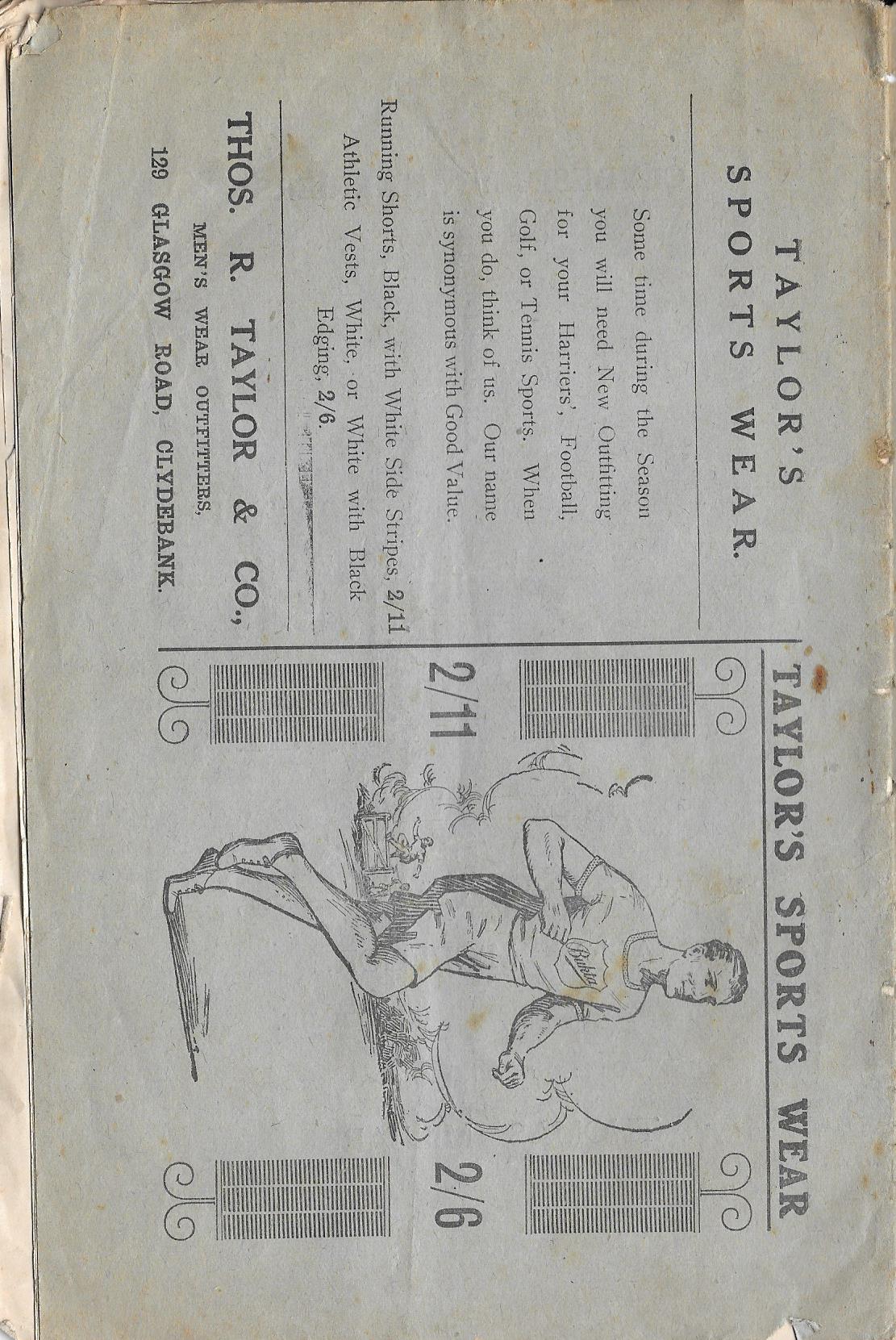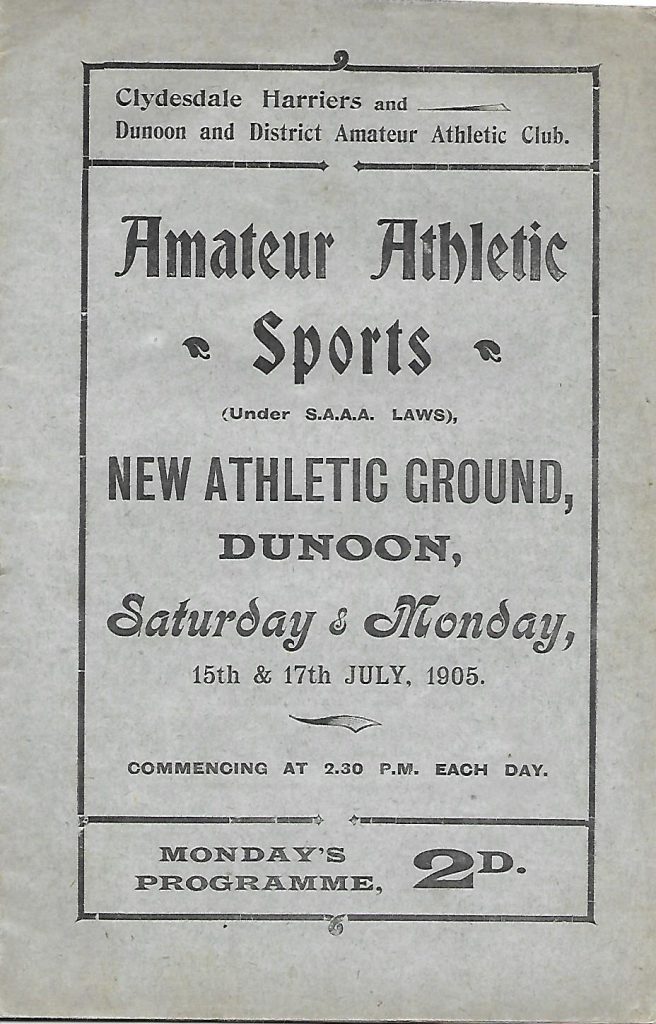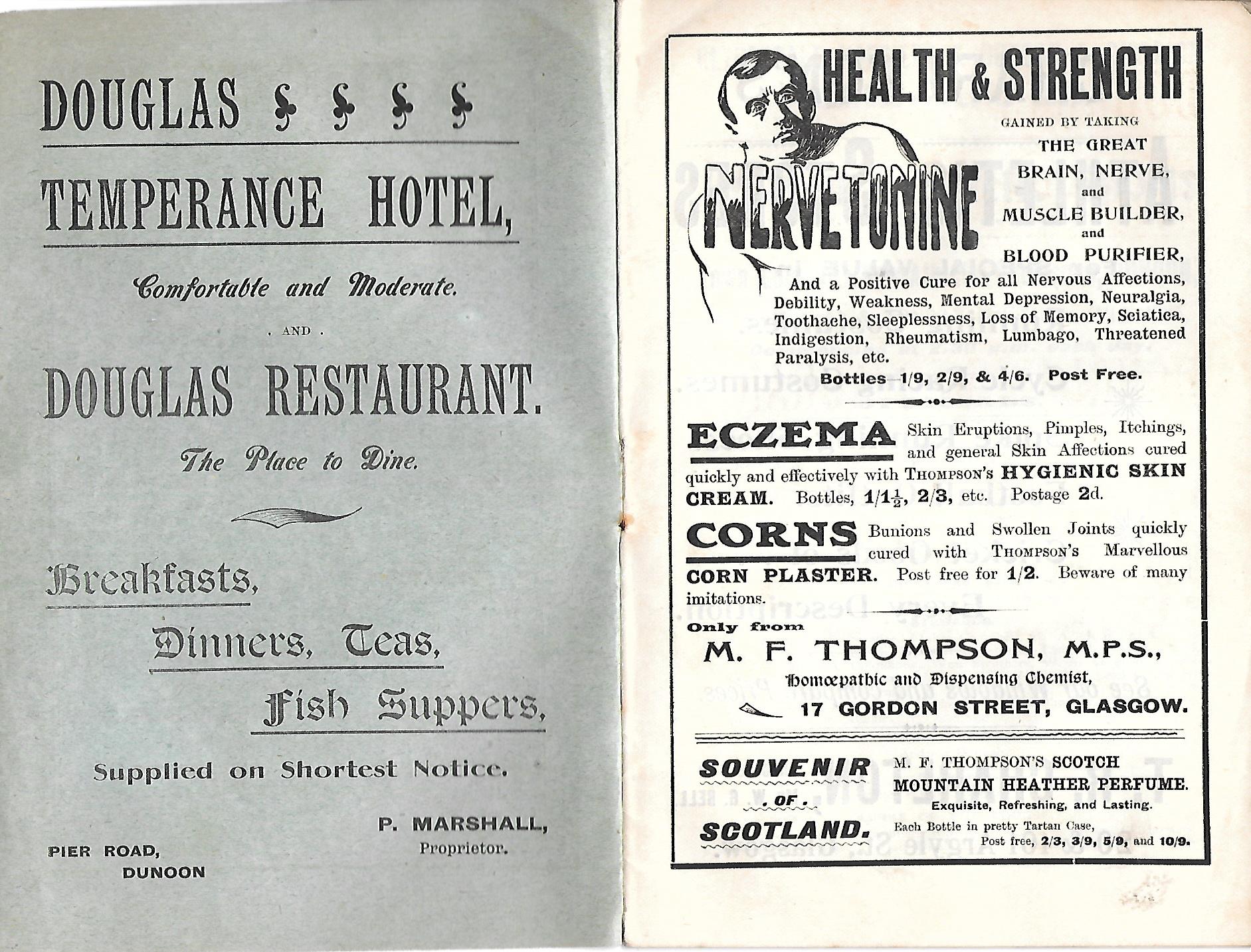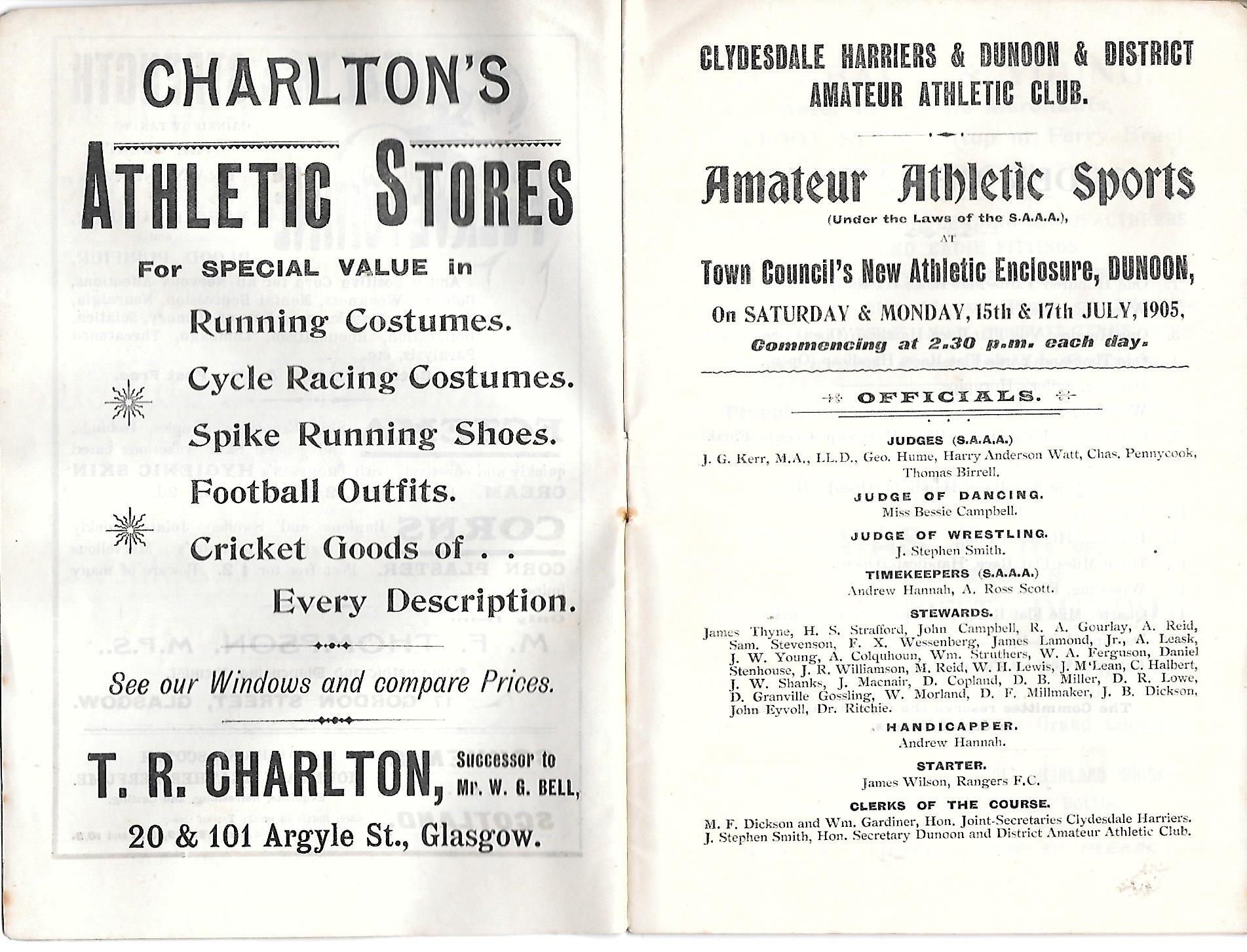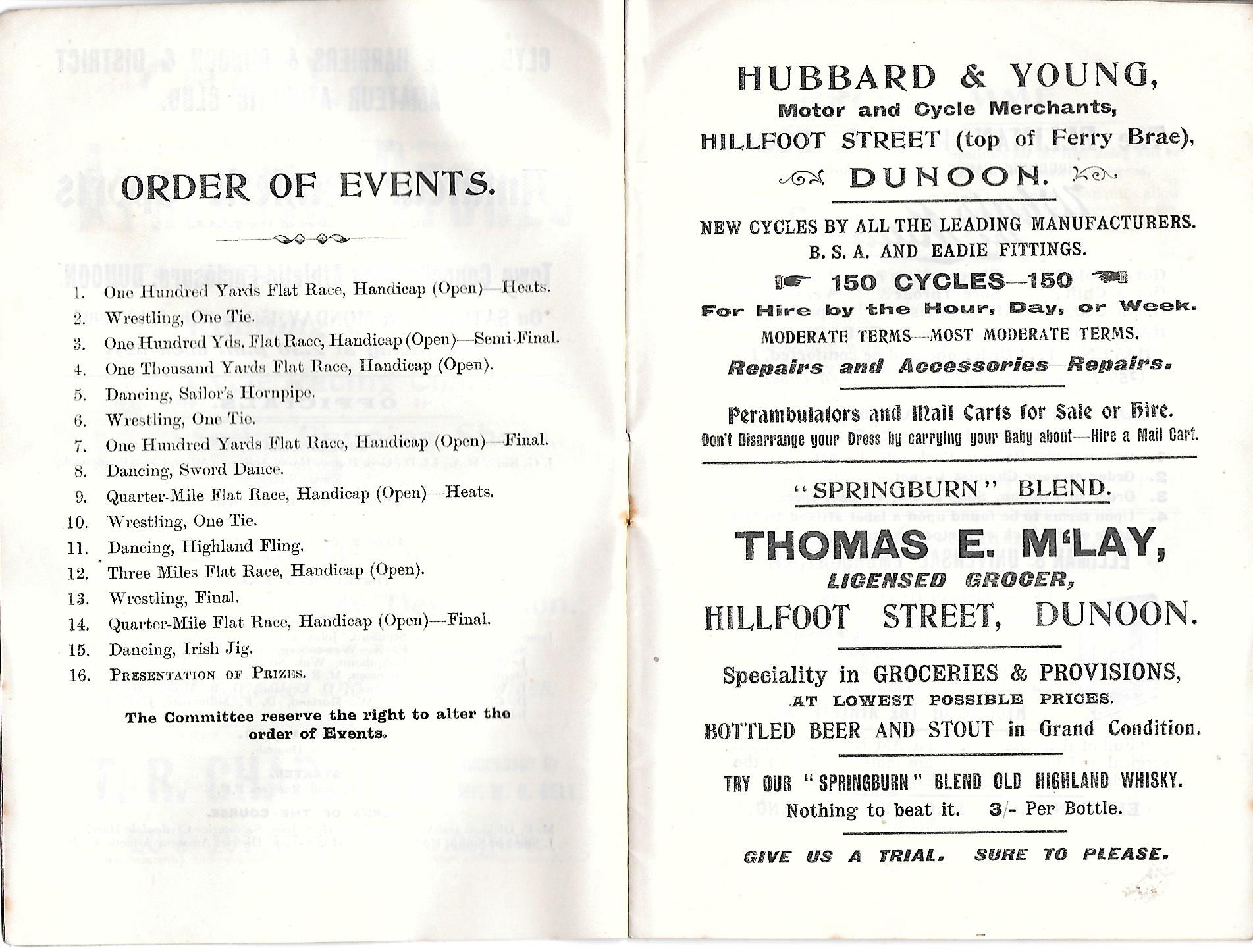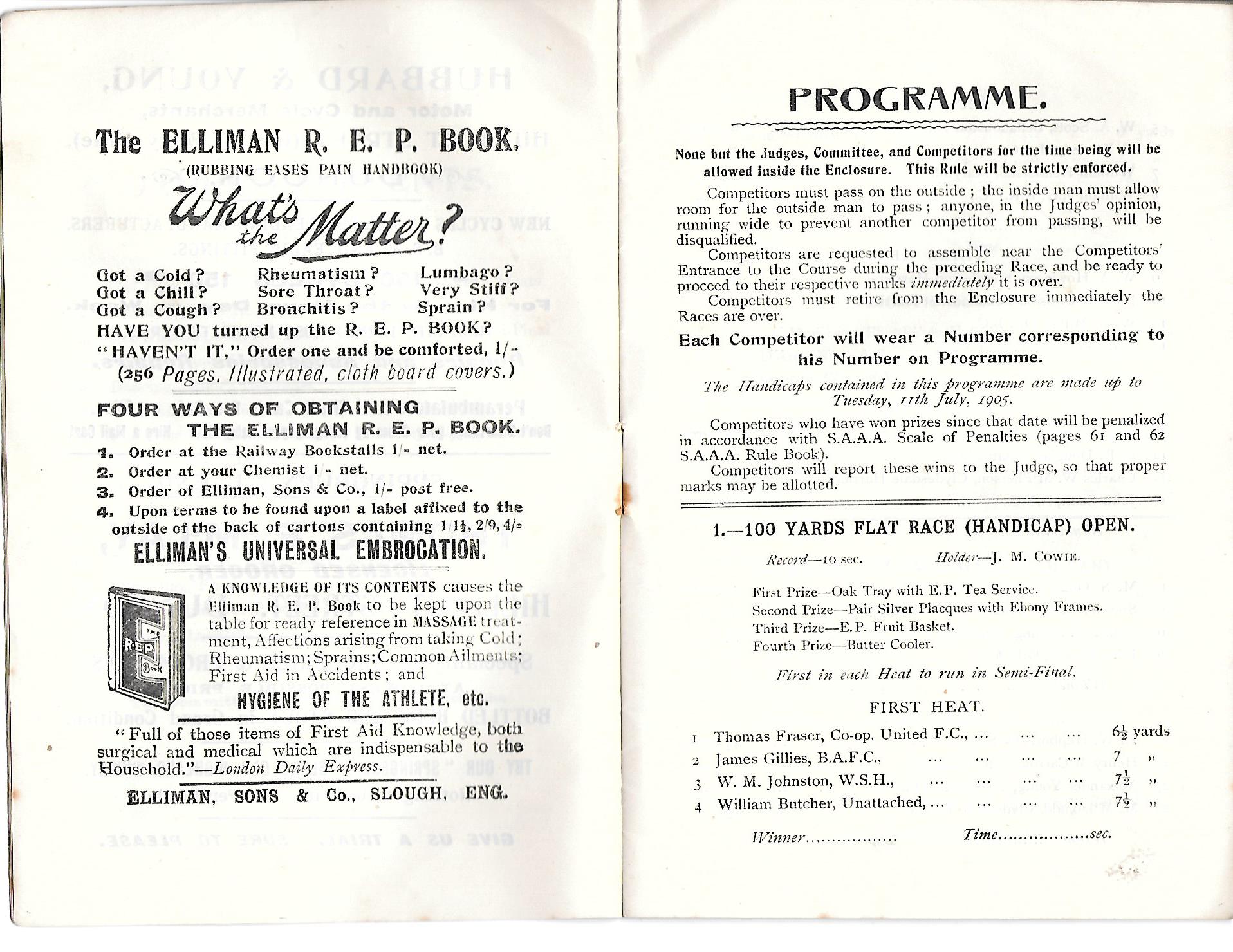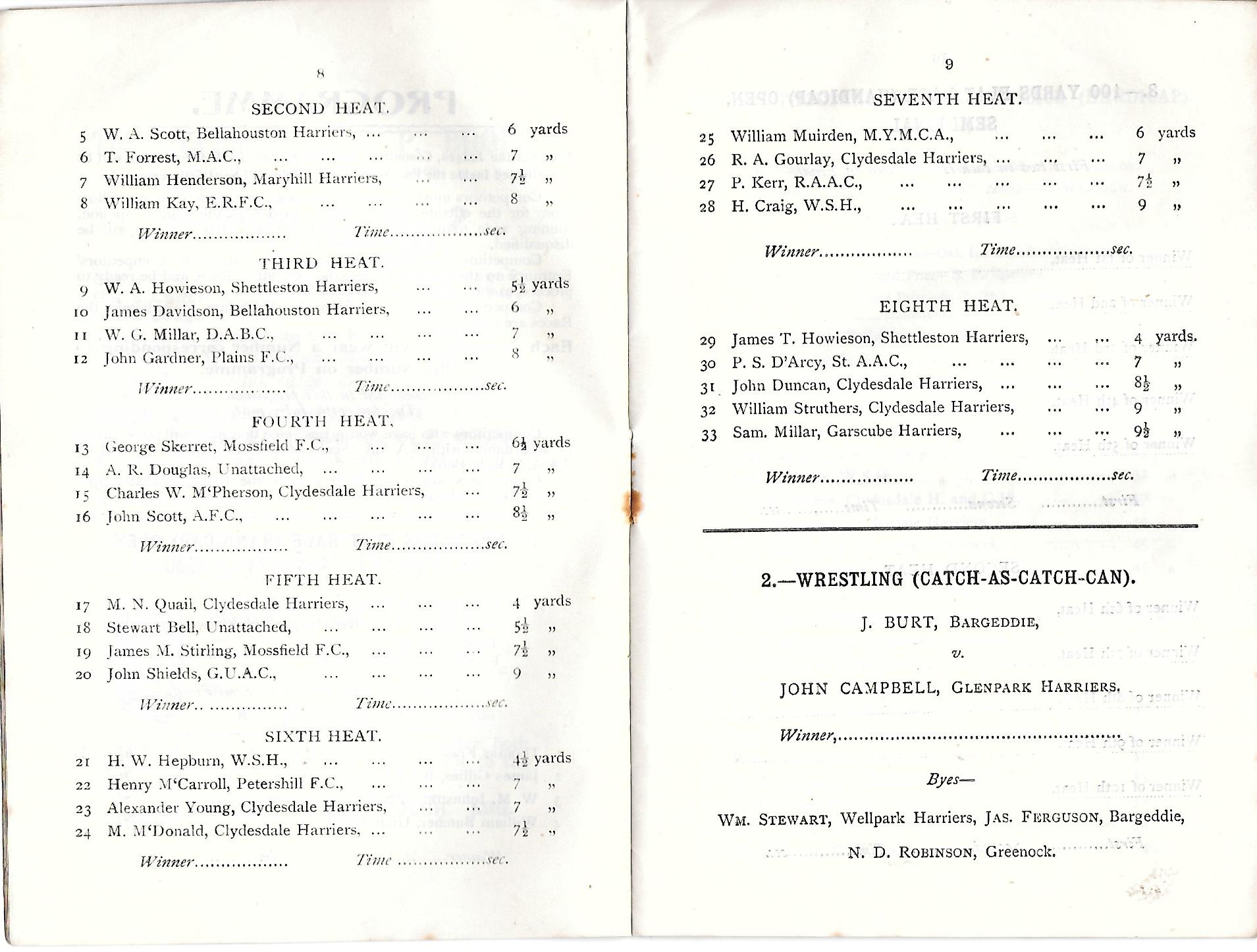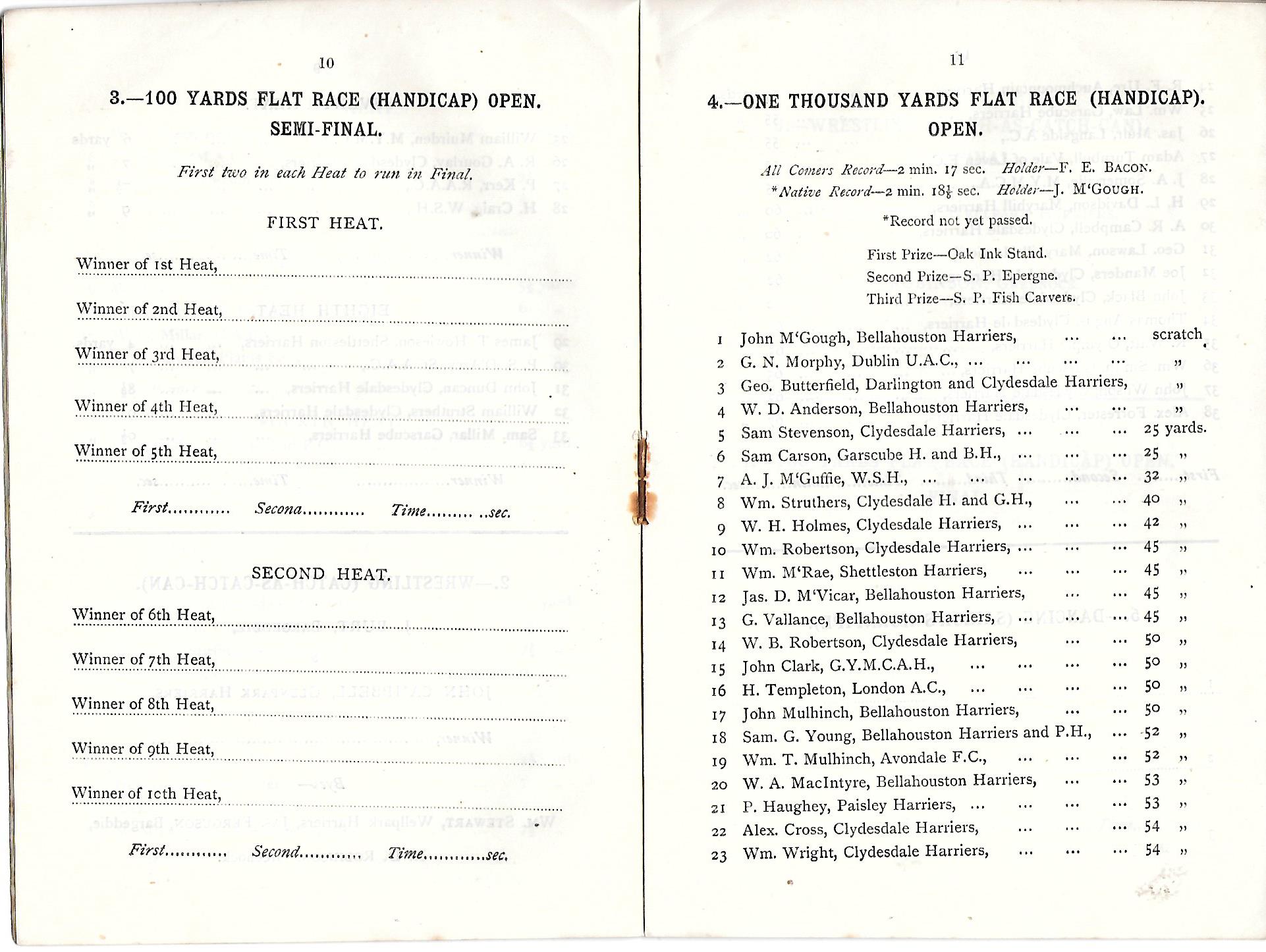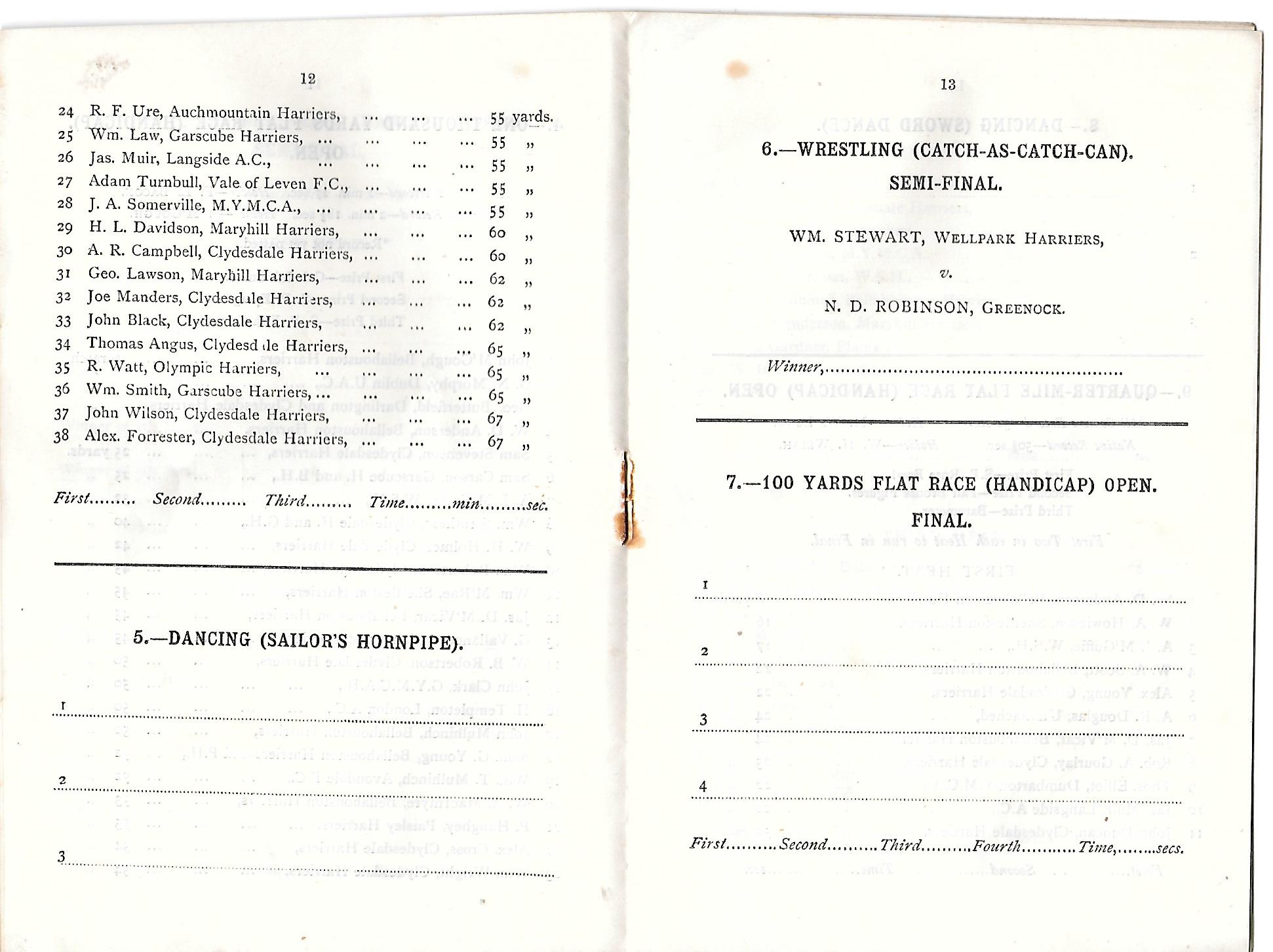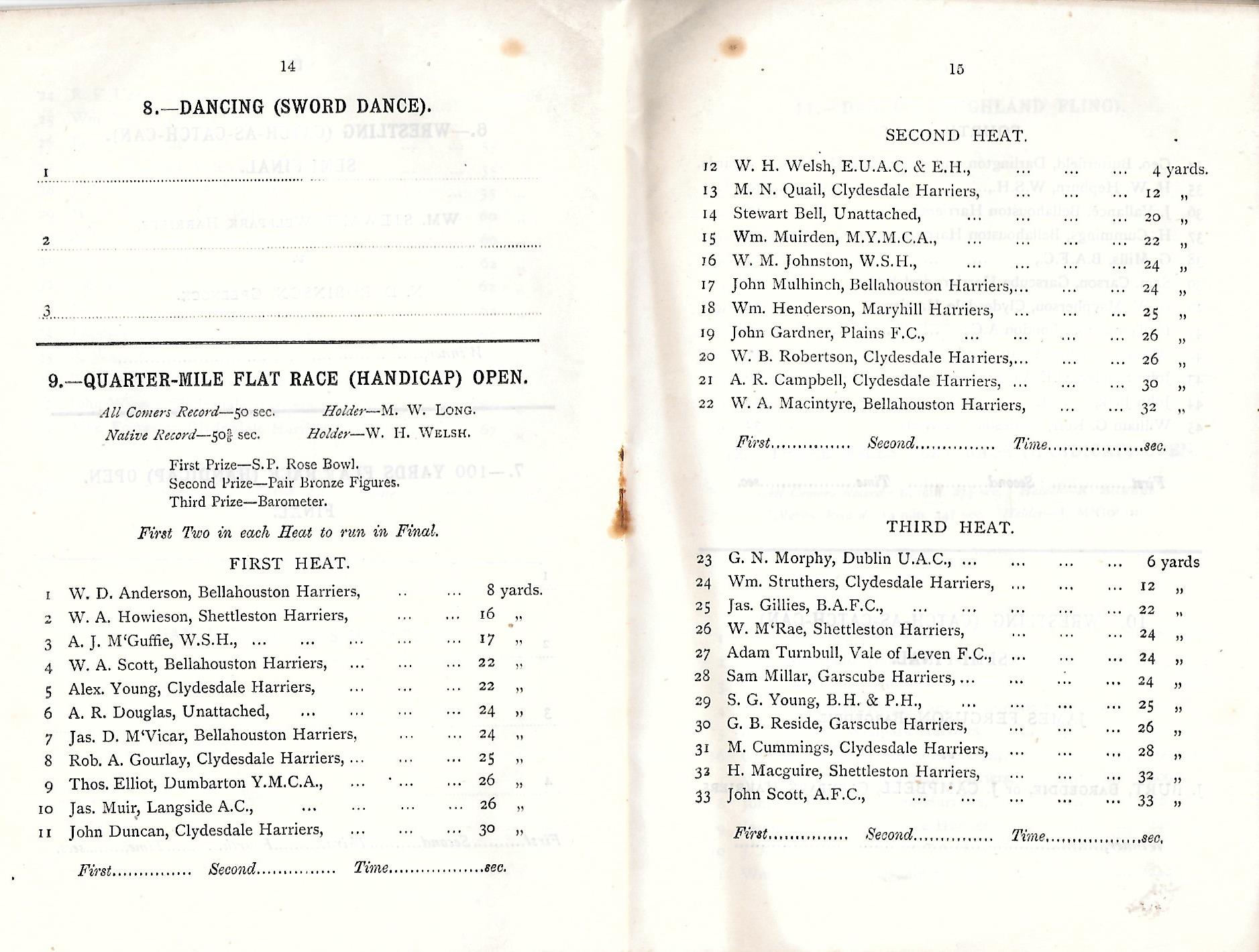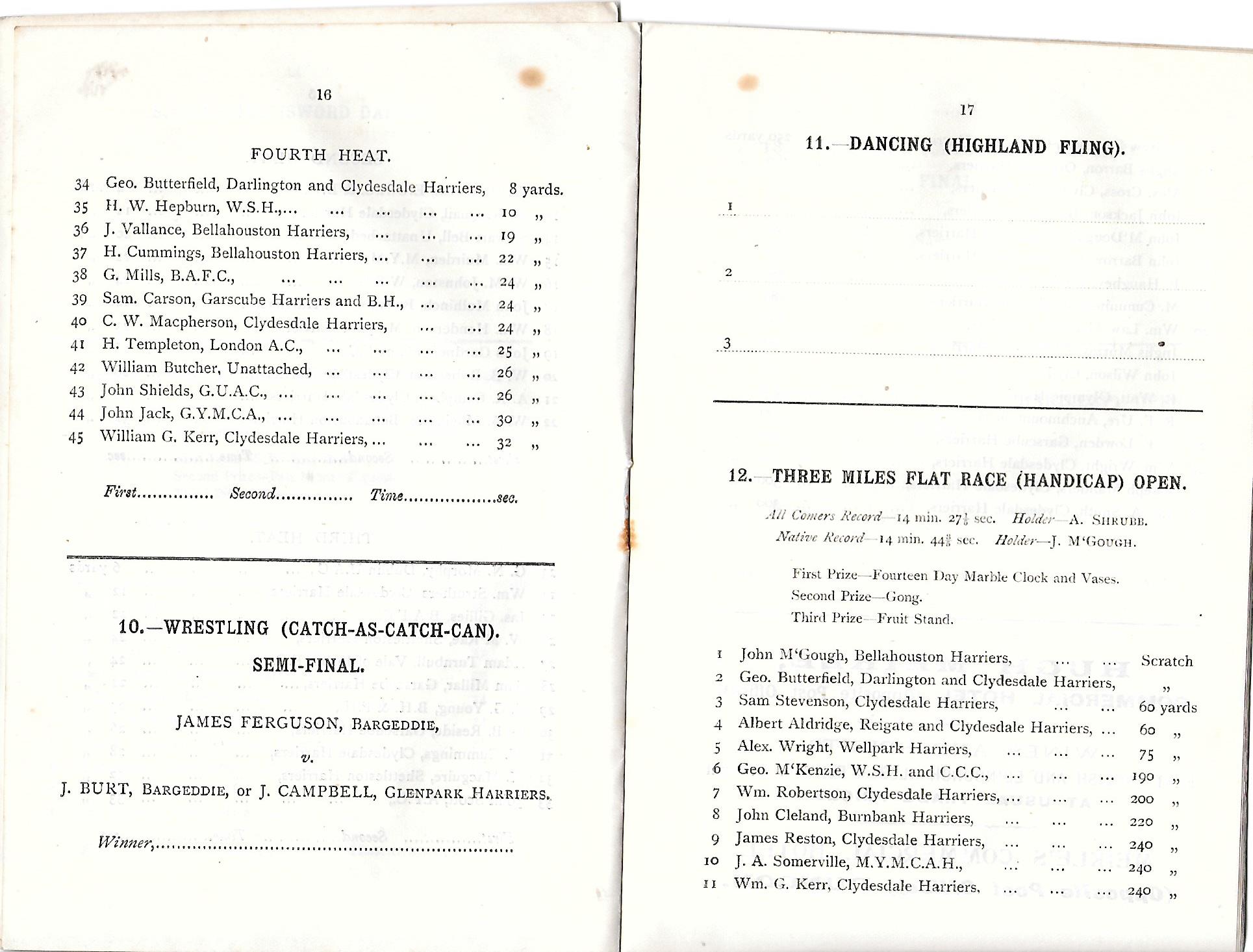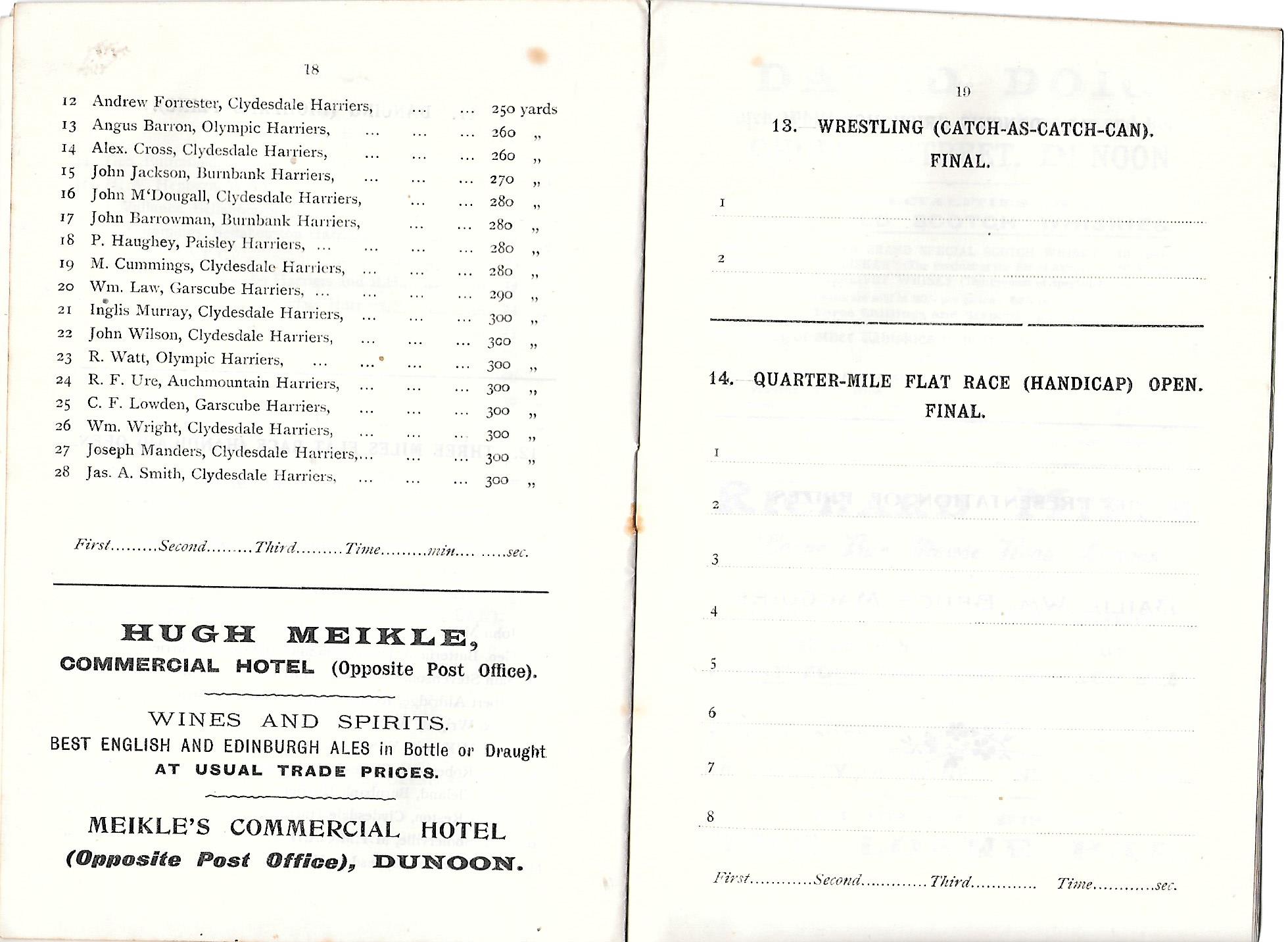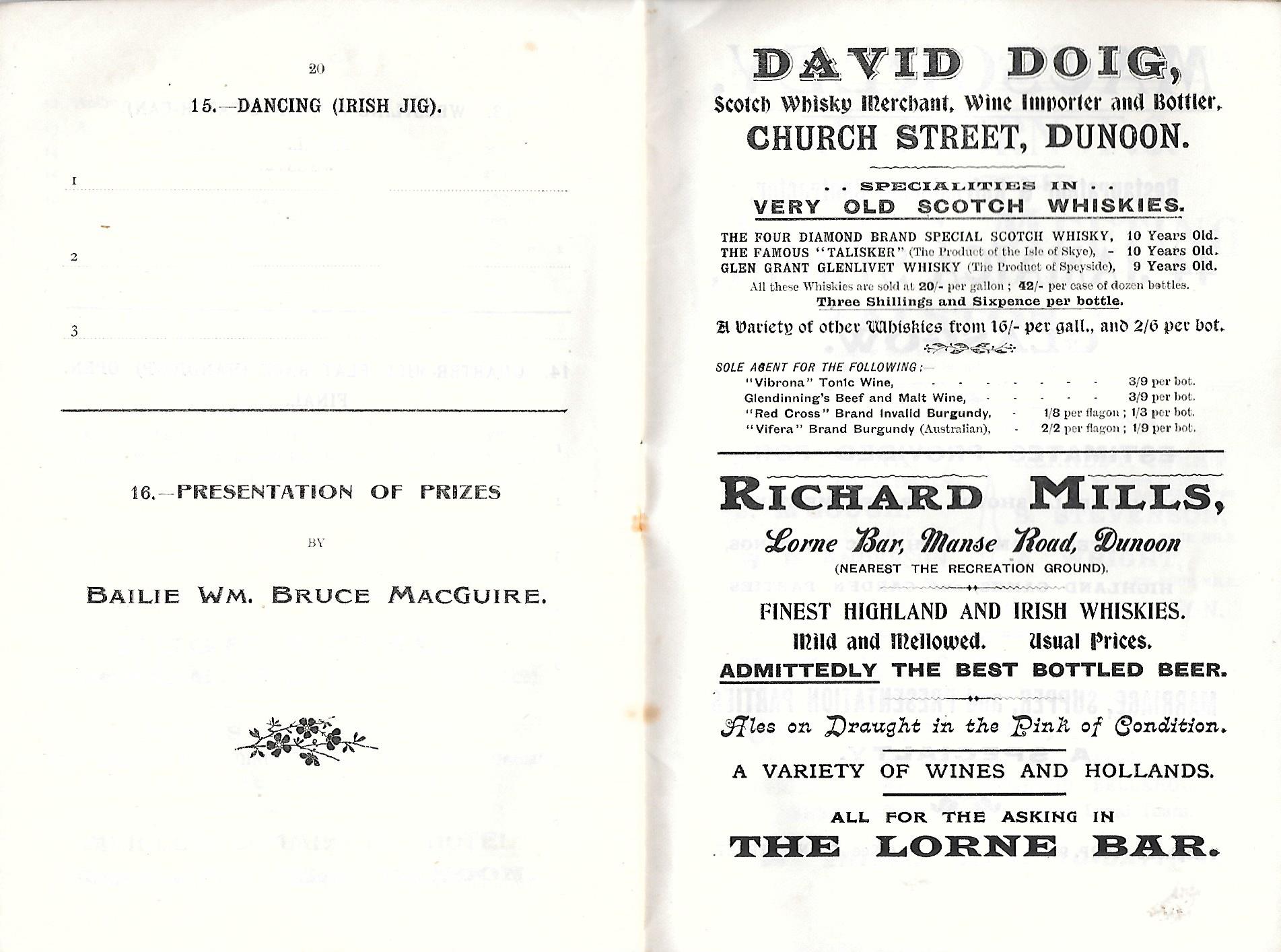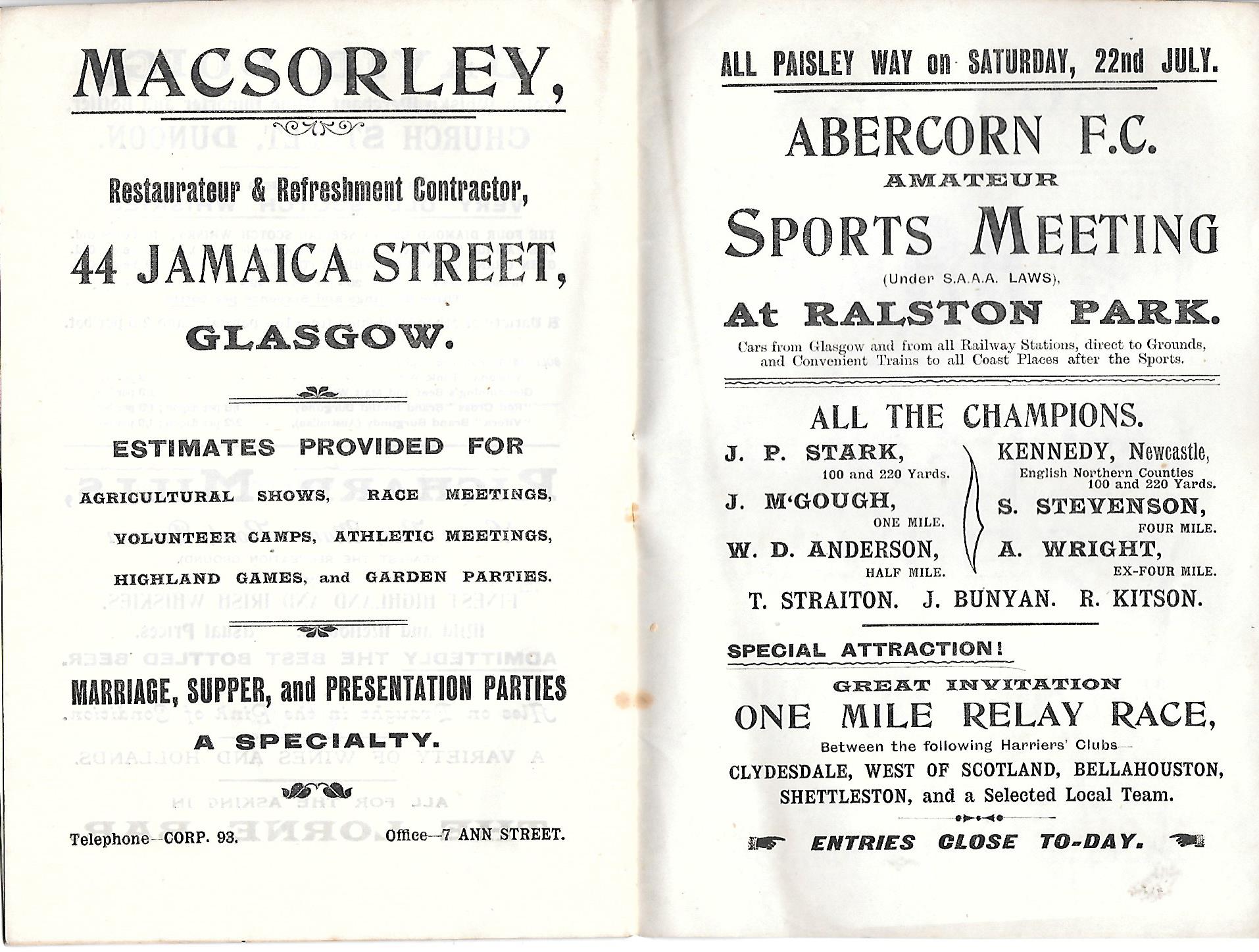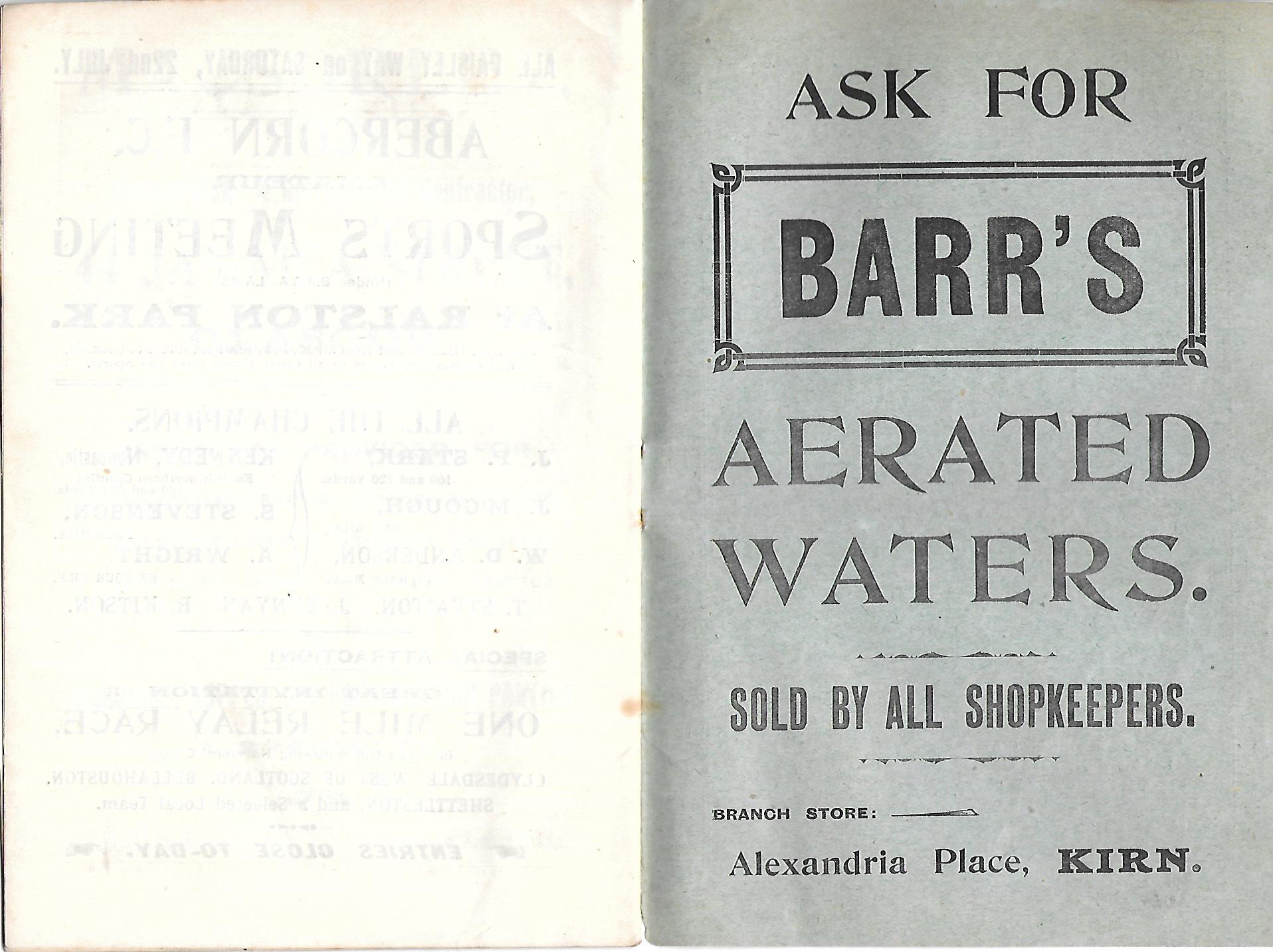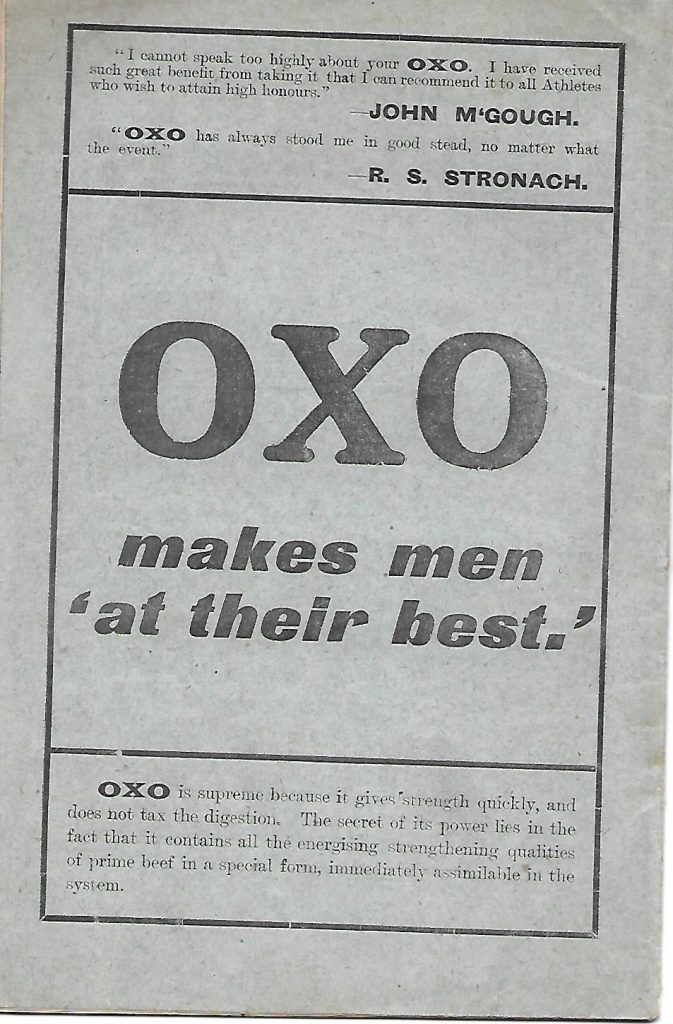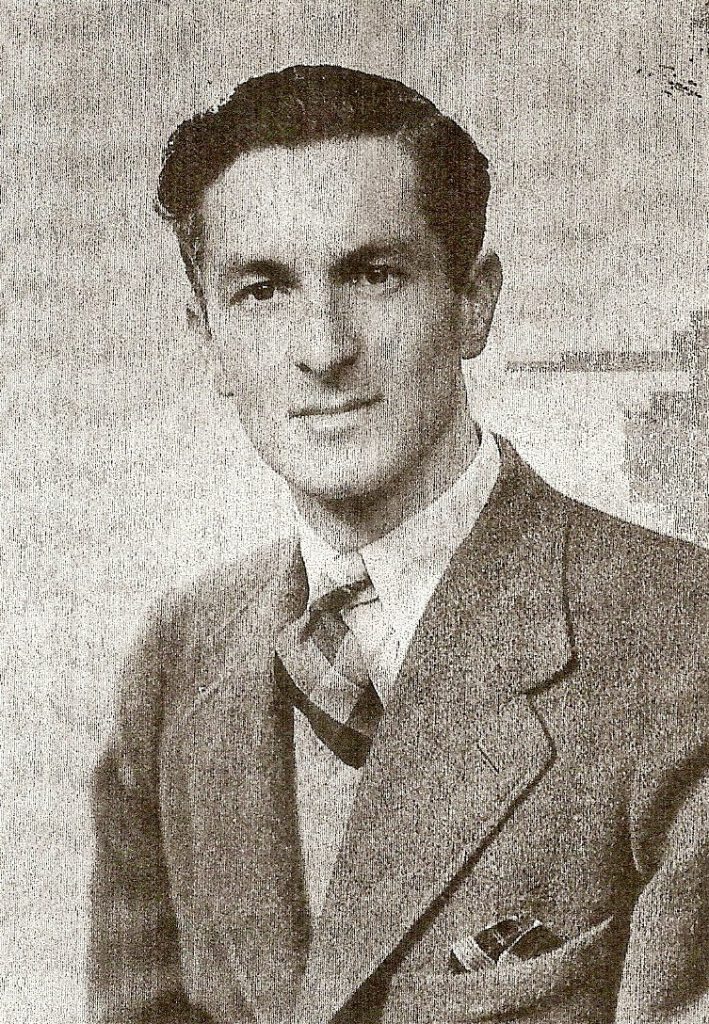
Bobby Boyd joined the club in season 1939-40 just as the war was starting and went on to be one of the best (and most unlucky) athletes ever to wear the club vest. Winning races at county and district level, he would have run more than five Edinburgh to Glasgow Relays had it not been for the intervening war years and a series of injuries.
One of four siblings Bobby was born in Duntocher in 1921 and his first sport was boxing. He took it up as a hobby and as a means of self defence and although he never reached any great heights as a boxer he was often sparring partner to good class Scottish boxers, notably Tommy McGlinchy who fought the great Benny Lynch. He always loved the country, hiking and camping and joined the Harriers just before war broke out. The War started and every factory in the country was put on war production. Sixty percent of all naval tonnage produced at the time came from the River Clyde and the Singer Sewing Machine factory had eighteen thousand workers turning out machine guns. By trade at the time Bobby was a Die Sinker which was considered vital to the war effort and he could not initially get permission to join the military. Eventually his persistence won the day and he was able to join the Air Force. It was near the end of hostilities and the RAF did not need any more pilots but he became a navigator/bomb aimer. Always clever he passed all the exams quickly enough but being stationed in Britain never saw action. He did have a lot of time to train however and he represented his unit in various One Mile races. At one point he was in charge of a group of German prisoners of war and saw to it that they all took part in his training regimen. He developed a problem with the cartilage in his knee at this time and required operations. In 1946 this was a serious operation and he spent time in Killearn Hospital during which one leg shrunk to little more than skin and bone. Starting from his release from hospital he began a determined training regime and a year later was winning mile races again. As his brother Jack says, “Intense training, focus and determination were to be Bobby’s approach all through his life.”
By 1947 he felt ready to race again and had what was certainly his best season ever between May 1947 and March 1948.
At the start of season 1946-47 he was still injured and working mainly as a coach in the club. In this capacity he had a tremendous thirst for knowledge and attended as many coaching seminars as he could. The main runners were George White, Pat Younger, Eric Paton, Alex Hylan and David Bowman but when he was injury free his ability shone. The ‘Clydebank Press’ report of 31st May 1947 reported on the good results achieved by the runners under his guidance at the Bellahouston Harriers Sports at Hampden adding “To crown the afternoon Bobby himself ran a fine race to win the Mile. The fine judgment of pace shown by our coach shows he has the capabilities of winning more races before the end of the season.” The following week he won the same event at Shotts Highland Games, then he won the Mile at the Dunbartonshire County Championships on the Thursday (and was selected for the Inter Counties Championship in the event) and at Singer’s Sports on the Saturday he was third in the Mile off a handicap of only 50 yards. This was three wins and a third in four races in three weeks! Not content with that he won the Mile in the Inter Counties Championship at Helenvale Park, Glasgow. In the Scottish Championships at Hampden, the ‘Press’ reported that he finished fifth out of 22 runners in the Mile. A week later he was second at the Sports in Linlithgow where the track was notoriously bad. In the club championships he won the Memorial Bowl for the club points contest with victory in the last event, the Three Miles: he had 30 points with Jim Young second on 28 and George White on 20.
With the summer season finished, he was commended by the President, Andy McMillan, who referred to his fine example and coaching, and elected to the position of captain. The winter season started with the trial for the McAndrew Relay and it was won by Bobby and George White. The ‘Press’ noted that “Training is continuing under the guidance of Mr R Boyd who has commenced classes for exercises after the runs and is receiving a good response from the members.” In December he showed his real ability in the Midland District Relay at Motherwell. George White ran well enough to be fourth on the first stage, Doug Scott dropped to eleventh, Jackie Higginson came up a bit to tenth before Bobby pulled up to seventh place. One well known runner is said to have remarked that “he came through them like skittles” on what was a short hilly course but the real surprise was his time – 12:51 gave him the fastest time of the day. He was quicker than Andy Forbes, Emmett Farrell and all the other top runners on display. The report by Eddie Taylor in the ‘Scots Athlete’ of January 1948 said “R Boyd, Clydesdale, astounded most spectators by returning fastest time against a top notch field but his club were not surprised and with a little stronger support for Boyd and G White, Clydesdale would be ‘shaking up’ the leaders.”
The next race was the Dunbartonshire Cross Country Championship at Milngavie in January which he won by 50 yards. Incidentally the spacing of the races was more civilised than at present and was a lot kinder to the limbs. One week later he won the club championship for the first time defeating George White by 600 yards. Two weeks later in February the club travelled to Pollokshaws for the Midland Championship and Bobby won that one as well to be the first Clydesdale Harrier ever to do so. This was a real turn up for the books given the standard of athlete competing. The report in the ‘Scots Athlete’ of February 1948 read as follows: White and Boyd (Clydesdale) with Craig (Shettleston) led the field for the first lap, and on the second circuit being completed Craig was endeavouring to shake off the longer striding Boyd, followed by Kidd (Garscube), Lennie (Vale of Leven) and White leading a group close behind and it was most striking how Garscube and Maryhill team members were ‘packing’ well up, and their finishing places are a perfect illustration of teamwork ‘par excellence’. At the finish Boyd, striding strongly through the tape proved a worthy winner.” The team finished fifth with George White sixth individual.
Emmett Farrell’s National preview mentioned Bobby in the following terms: “I fancy the chances of the winner emerging from the following quartette:- R Boyd (Clydesdale), A McLean (Bellahouston), JC Flockhart and G Craig (Shettleston). Boyd, a most stylish runner, and also very fast, has made a remarkable recovery from illness and has shown outstanding form all season over both short and long stretches. This may be his year and he has an opportunity to prove that he has adequate experience and temperament for the big occasion……” Unfortunately he could not make it a fourth championship win to go with the club, county and district championships. He had a real off day in the race at Ayr and could only finish thirty third with George White fifteenth and the team finishing sixth. Emmet Farrell himself won the race, just as he had done ten years previously. The story behind the story is that Bobby was still employed as a die sinker working with his hands and had just completed an emergency 36 hour shift immediately before this race so that he had only arrived at the venue in time to warm up. The ‘off day’ was easily explained!
That was the end of the cross country season and James Shields reported in the ‘Clydebank Press’ as follows: “The past cross country season is the brightest the club has enjoyed in many years. Credit for this must go to Bobby Boyd who has filled a very difficult dual role of club captain and coach. In addition to this Bobby set a magnificent example by having the fastest time in the Midland Relay and winning the Dunbartonshire and Midland Championship.”
The following summer he retained the Memorial Bowl for the club points contest, he won the County Three Miles championship, was first man home in the 2½ miles Round the Loch Race at Linlithgow and was third in the Glasgow Police Sports Invitation One Mile Race. He also ran at various other distances – eg at Ibrox he ran in the 880 yards and qualified for the Final where he was unplaced. Injuries cropped up. At one point the ‘Press’ report said that “The Two Miles Team were without the services of R Boyd who was incapacitated”, and at another his return from another lay off was mentioned. The incapacitation referred to was that following a work accident he had an arm in plaster up to the elbow!
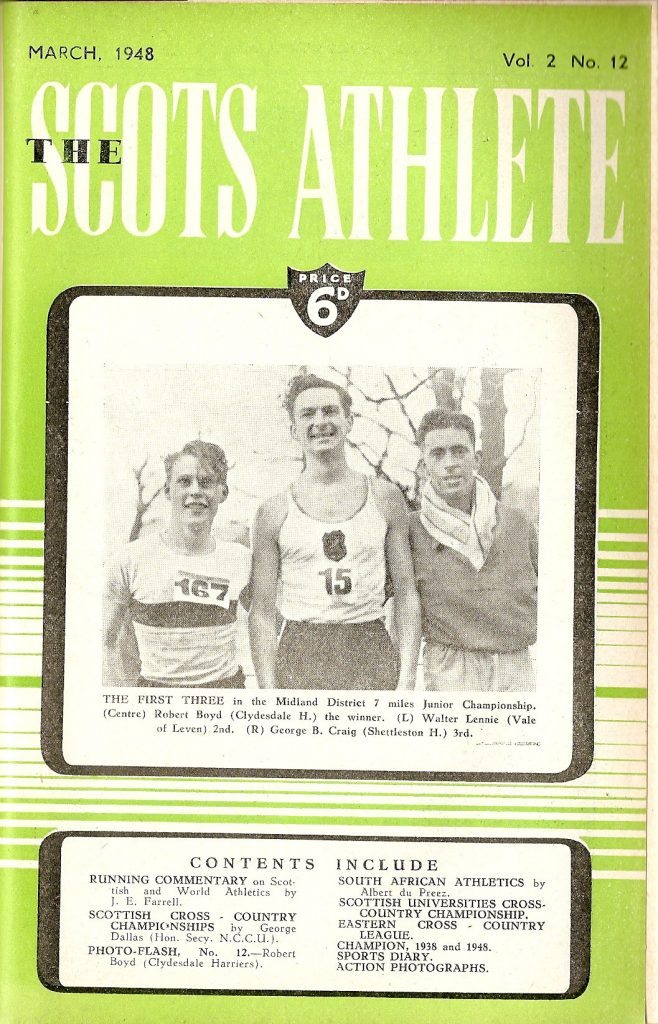
The ability did not go away but injuries started to take their toll. Initially it was not too obvious. He had the fourth fastest time in the McAndrew Relays in October 1948 and the team, minus George White, was seventh. In the Dunbartonshire Championships he finished second to Alex Kidd of Garscube after a hard fought race and missed the Midlands Championships. Came the National and Emmett Farrell was still predicting that he had a chance to make the Scottish team for the International Championship. He listed the obvious ‘picks’ and then said “A Kidd and R Boyd: Both are enthusiastic and ambitious performers and both are real triers. Last year they both, and particularly Boyd, had an off day on National Day. Now freed from Midland worries they should do better this year. Kidd recently beat Boyd decisively in the Dunbartonshire Championships but in relation to the National this is not conclusive proof of superiority. Both have to break down the mental barrier of non-success in the National. In other words previous success gives a runner confidence that he can repeat the performance. Both have a chance even if it is an outside one.” However in the National Championship at Ayr he was twenty fourth and, in the absence of George White, first club man home. He even lost the club championship after only holding it for twelve months. The race itself was held at Ayr Racecourse and, added to the extreme cold on the day, sleet fell for the entire duration of the race. Alex Kidd was carried from the finish exhausted and maybe suffering from slight hypothermia if eye witness reports are accurate. He was ill for a while afterwards. Alex Hylan, running in the Youths race, caught pneumonia and ended up in a Co-op convalescent home across the Tweed from Abbotsford.
Came season 1949/50 and he was again easily the fastest in the club being 12 seconds ahead of White in the McAndrew Relay but he was a minute slower than the fastest time. In the County Championships on 15th October he was only the third quickest club runner behind White and Pat Younger. He was still being described as a ‘classy runner’ but the injuries were taking a toll. In the Midlands Relay at the end of October he was fastest club runner but a minute down on the top men. The time table was letting him down; three races in a month are not the best treatment for any injury. In the Midlands Championships in February 1950 he could only finish 68th which was 36 places behind George White and only one ahead of Joe Duffy. Came the National at Hamilton and given his season up to that point no one was tipping him for the Scottish Team. He finished 61st – one place ahead of David Bowman who would never have called himself a top cross country runner. Bobby went on running for the club in cross country, track and road races but it was becoming clear that he would find it difficult to reach the heights of the 1947/48 season again.
He won several of the most respected trophies in the club at a time when it was strong in middle and long distance events but none was after 1950:
The Semple Merit Award in 1948;
The Championship Challenge Cup in 1948 and 1949
The Memorial Bowl in 1947 and 1948
However unlike many top class athletes he did not walk away when injury caused him problems. He ran whenever he could but crucially he remained club coach assisting many club runners to excellent performances: George White for instance spoke highly of Bobby’s contribution to his successes. Jim Young came along to the club at the instigation of Hans Noble but immediately he was told to train with Bobby. The same is true of many others. When the club was third team in the National Cross Country Championship in 1955, a conscious decision was taken at the start of the winter season to train as a group on Mondays and Wednesdays as well as the usual club nights of Tuesday and Thursday with the Saturday run also in there. The runners would meet at 8:00 or 8:30 pm after work and train as a group under the guidance of Bobby Boyd. He played a big part in this club success.
Clydesdale Harriers has had a great tradition of club runners taking part – often with great success – in the Ben Nevis Race; many of the major figures in the club contested the race including Pat Younger, Frank Kielty, David Bowman, Bobby and Jim Shields, and Ian Donald along with many who went for the run and the fun. Bobby was among the first, if not the first, Clydesdale Harrier to take part in this supreme test. He competed many times. His daughter Elaine tells us that the last time they went to the Ben race, they got up at about 4:00 am to drive to Fort William. The weather was wet and rainy and really bad. After the race the car developed a problem that could not be fixed right away and there was not a room to be had in the Fort at that time of the year. In the end they took a taxi from Fort William to Broughty Ferry where they were living. She adds that his life was so full of sport that he spent most of his free time when not at work either running, golfing, watching athletics on TV, training people, swimming, etc.
Another initiative that he started was the long Sunday walk which had formerly been a major part of training but which had fallen by the wayside. Where Jock Semple and the runners of the twenties had walked round the Three Lochs on one occasion and usually did some long Sunday walk, Bobby had Frank McKay, Jim Young, George White, Willie Howie, including at times his brother Jack Boyd and others go over the Moors to Carbeth and back. Sometimes they walked over the Kilpatrick Hills and there was often a wee ‘burn up’ up Duncolm (the highest top in the hills) where Frank MacKay (“with his chunky powerful wee calves!”) was the man to beat! One of the favourite walks started with them meeting up at the Hardgate Cross about 9:00 am. They then headed off across the moors (there was no Faifley Housing Scheme at the time so it was straight on to the open country. Then it was over Milngavie Golf Course and on to a farm where they bought milk and scones before returning home. As well as adding to the general fitness level it helped build team spirit and identification with each other and the club. Nowadays they would call it a bonding exercise! At times when something important was coming up, this became Sunday training at Mountblow with the runners doing repetitions of distances up to 600 metres under his supervision.
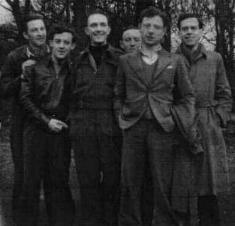
On a walk over the Moors:
Bobby, George Haddow, George White, Jim Young, Frank MacKay, Jackie Higginson
Wherever he was when away from Clydebank and the Harriers, he kept to his own fitness regime. His daughter tells us that he always went for a ten mile run on Sundays – if possible in the hills. In Dundee he ran in the Sidlaw Hills, in Largs when they were staying with her grandparents whose front garden had a view of the hills they would wait for him to get to the top and wave down to them, in Stonehaven he did ten one mile laps of Mineralwell Park which he had measured to be exactly one mile. Like Dunky Wright, he didn’t see fitness as a duty but as a pleasure.
Like all the others at the time, he did what his club needed him to do. He was a valued Committee Member and although he never held any of the three big offices of President, Secretary or Treasurer he did serve as club captain and his counsel was always well received. He also encouraged others to come to Committee Meetings. One club man said that when Bobby asked him to come along he wondered what he could contribute but he realised after not too long that he was able to work on the Committee. Eventually that man became club president.
Away from the club he had been a departmental manager in the huge Singer factory and had a short spell in the United States in the 1950’s. While there he had the idea of running up the Empire State Building stairs, so he went along in his running gear, explained to the guard that he had run up Ben Nevis and what he wanted to do. The guard just put his hand on his holster and said that he would have to pay like everyone else! His daughter Elaine, now living in Australia, says he was equally dedicated to his work and could remember holidays being cut short because he was itching to get back to make sure that everything was OK.
He returned and finally settling in Stonehaven near Aberdeen. When he was there he started training the ATC lads in the park and fostered an interest in athletics with some of them going on to competitive sport. The boys all loved him. He was interested in all kinds of sport but golf became a favourite with him too. He played every weekend and more often after he retired. However the many years of bone grinding on bone after his cartilage had been removed had its effect and Bobby had to have a knee replaced. The surgery went well and he assiduously exercised the knee until he could ride a bicycle. He did this in place of running but with the same enthusiasm. He lived at the top of a hill in Stonehaven and used to ride the bike down to the shop, pick up what he wanted and push the bike home up the hill with the shopping hanging on the cross bar. His friends used to accuse him of using the bike as a Zimmer! He had been diagnosed as having Parkinson’s disease at the age of 70. This inevitably restricted his lifestyle but he had always possessed a good singing voice and he used it to sing ‘for the old folks’ in various groups, such as the Alzheimer’s patients, around Stonehaven while holding on to the back of a chair to disguise the tremors Parkinson’s inflicted on his hands. He never felt sorry for himself – brother Jack tells of him saying on the phone that he was the luckiest guy in the world and meaning it. He kept up the regular exercising and then when Jack found some exercises for people with Parkinson’s on the internet, Bobby immediately incorporated them into his exercise regime. It was there in Aberdeen that he died on 15th September 2002 at the age of 81 of a massive stroke after battling the disease for almost 30 years.
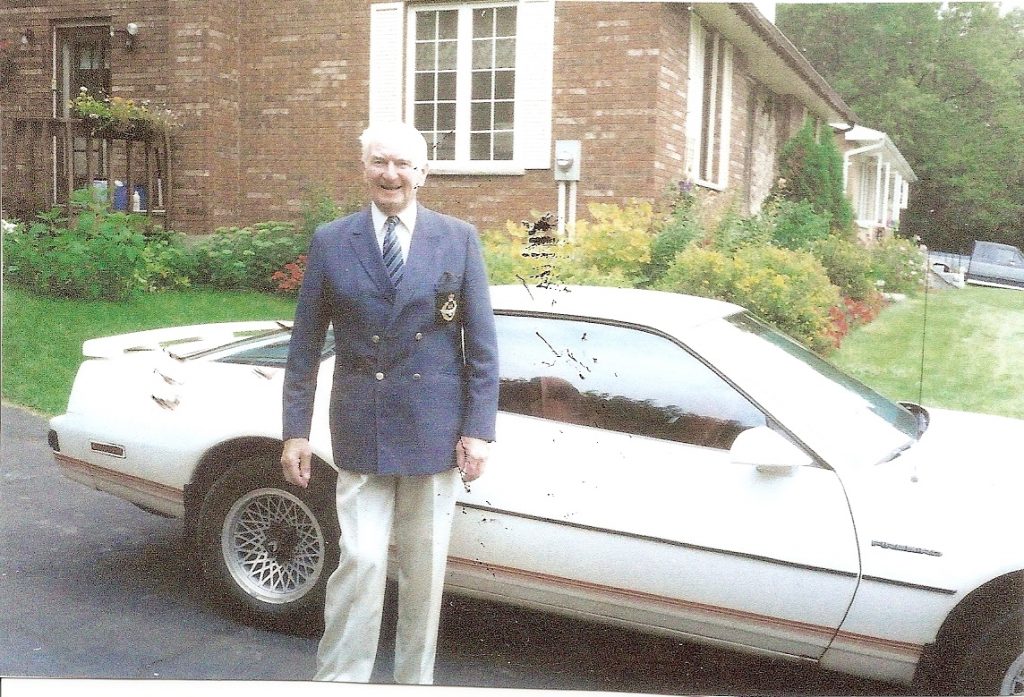 Bobby at 73 years of age
Bobby at 73 years of age
Runner, coach and committee man, Bobby filled them all admirably. Like many of the best men he always found time to contribute to the local community – look at the work with the ATC in Stonehaven for instance He was popular with all the local Dunbartonshire and Glasgow clubs and with the individual athletes in them but his tremendous influence on Clydesdale Harriers in the post war period was incalculable and he is still spoken of by all who knew him – and by some who only knew him by repute.
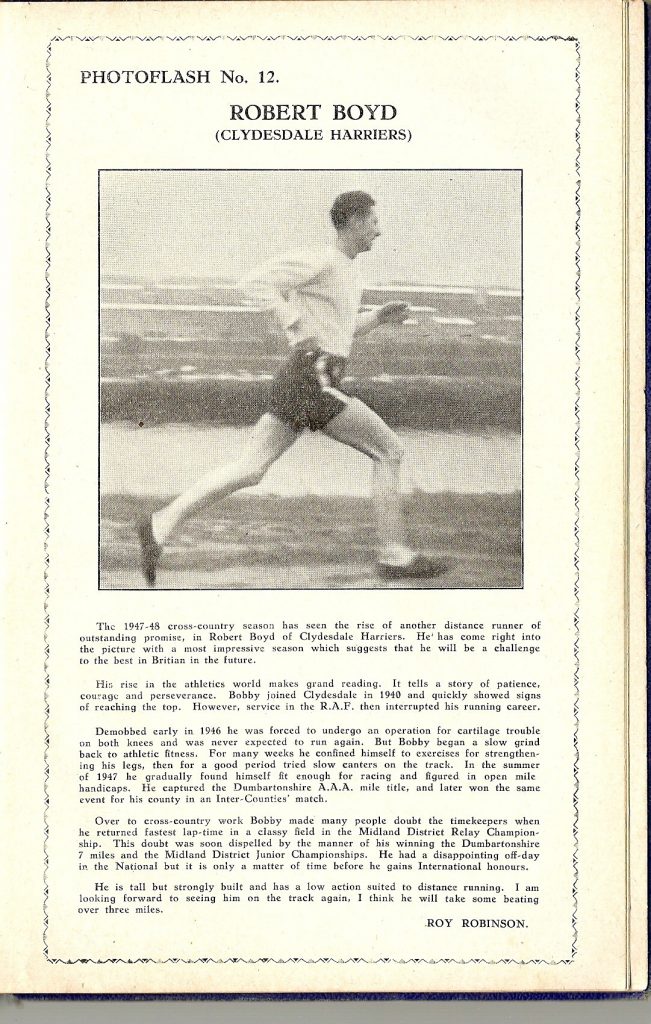
From the ‘Scots Athlete’ magazine of March, 1948
